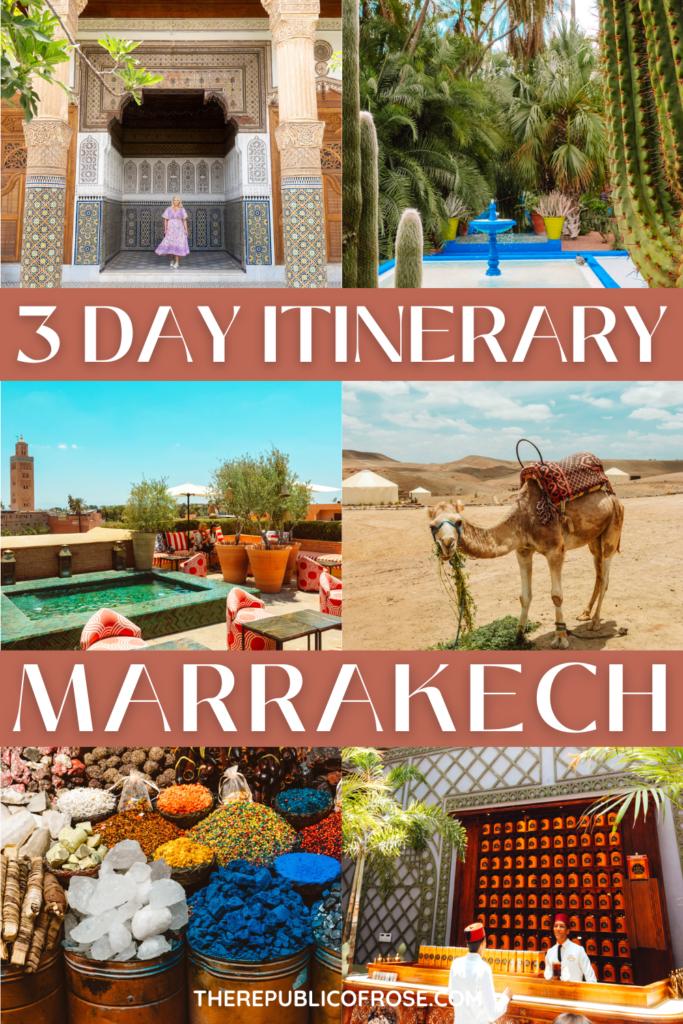
Planning your first visit to Morocco and want to know how to spend an unforgettable 3 days in Marrakech? This guide will cover everything you need to know including how to plan your visit and exactly what to do with 3 days in Marrakech!
While visiting Portugal, my mom and I decided to take a long weekend trip over to Marrakech since it’s an easy flight. It was both of our first visit to Morocco (and my first visit to the continent of Africa!).
Marrakech is known for its colorful souks, beautiful architecture, enchanting riads, and captivating energy. The city is a great introduction to the captivating country of Morocco!
I spent countless hours researching all the best things to do in Marrakech to come up with the perfect itinerary… And I couldn’t have been happier with how our trip turned out.
Here’s the ultimate 3 day Marrakech itinerary!
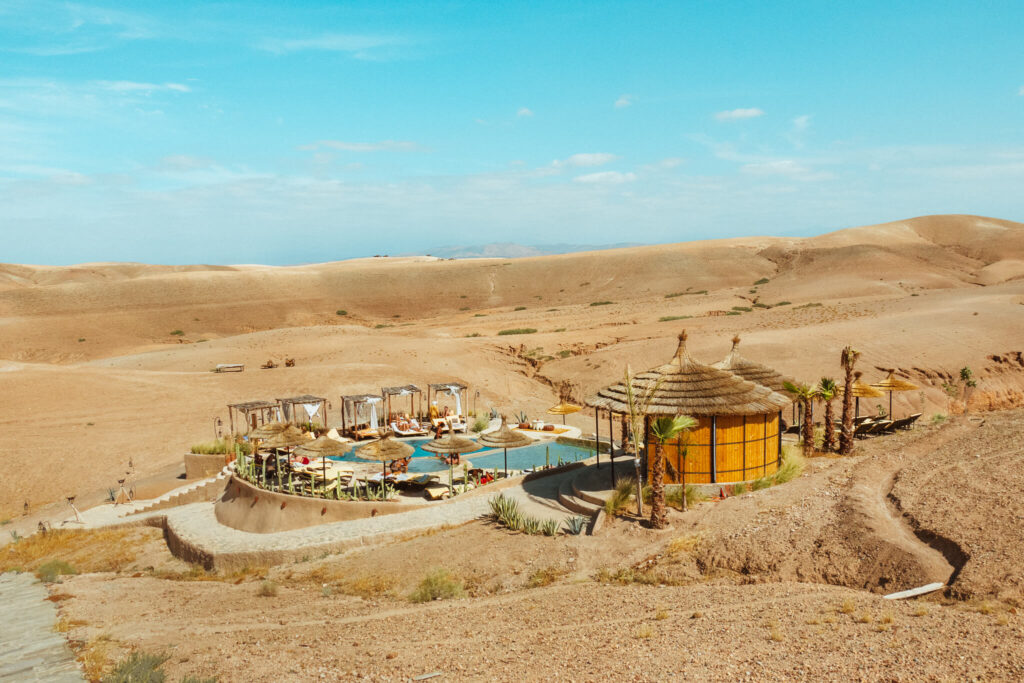
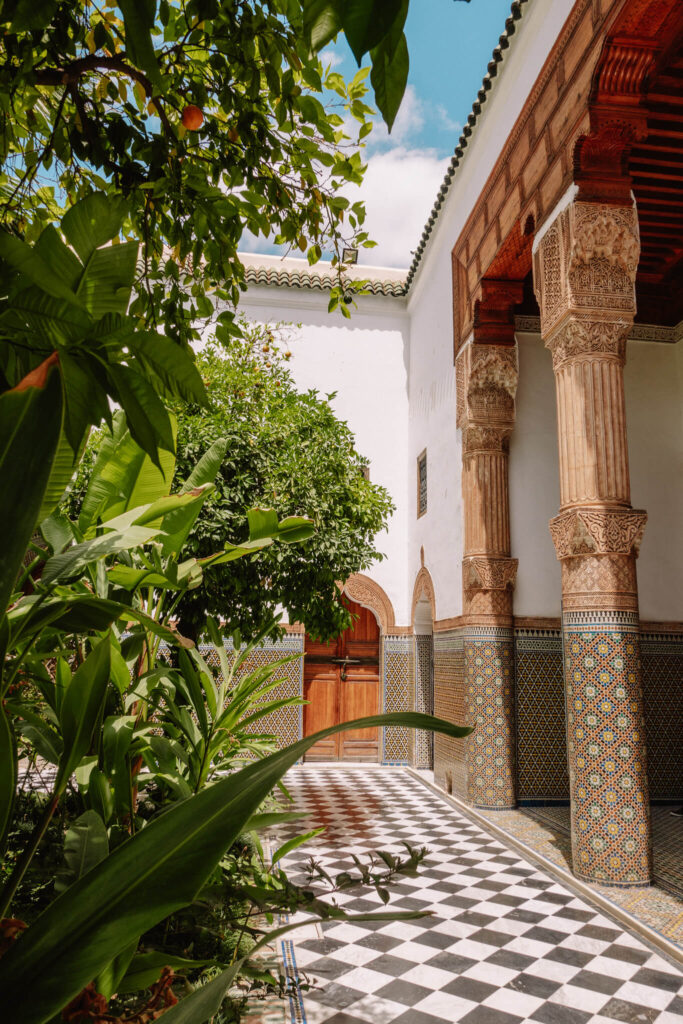
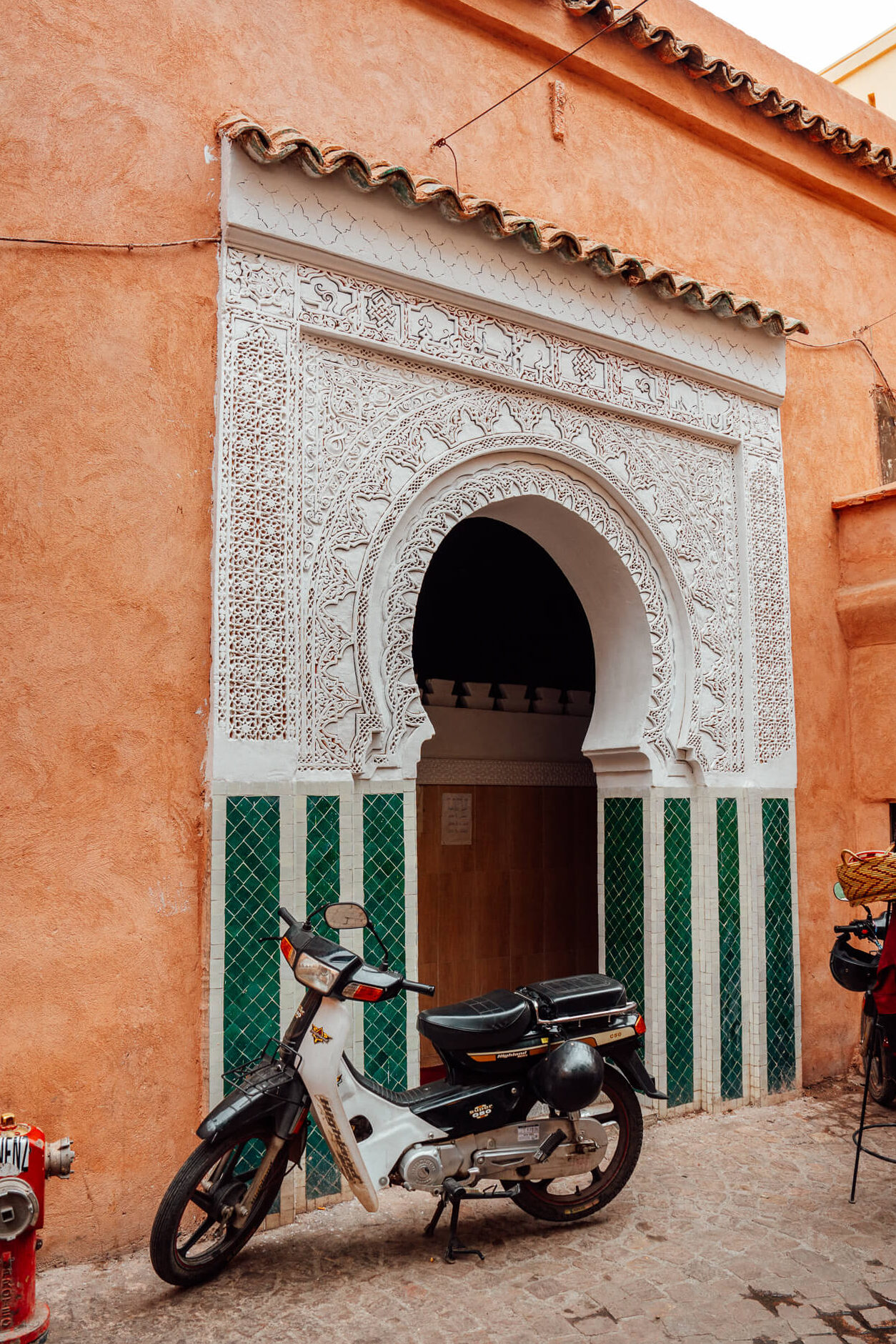
About Marrakech
Marrakech is a vibrant and historically rich city located in western Morocco. It’s one of the country’s major cultural, economic, and tourist hubs, known for its historic city center, stunning palaces, and vibrant atmosphere.
The heart of Marrakech is its old city, the Medina, a UNESCO World Heritage Site filled with narrow winding streets, bustling markets, and historic sites.
The city also serves as a gateway to the stunning Atlas Mountains, offering opportunities for trekking and exploring Berber villages nearby.
Who are the Berbers?
Curious who the Berber people are?! I was as well, and luckily got to learn much more about them while visiting Marrakech.
The Berber people are an indigenous ethnic group primarily indigenous to North Africa that have a rich history dating back thousands of years. They are considered to be among the original inhabitants of North Africa, with a heritage that predates the Arab-Islamic conquest of the region in the 7th century. They have their own language and cultural practices and were often nomadic but also settled within villages in the Atlas Mountains and beyond.
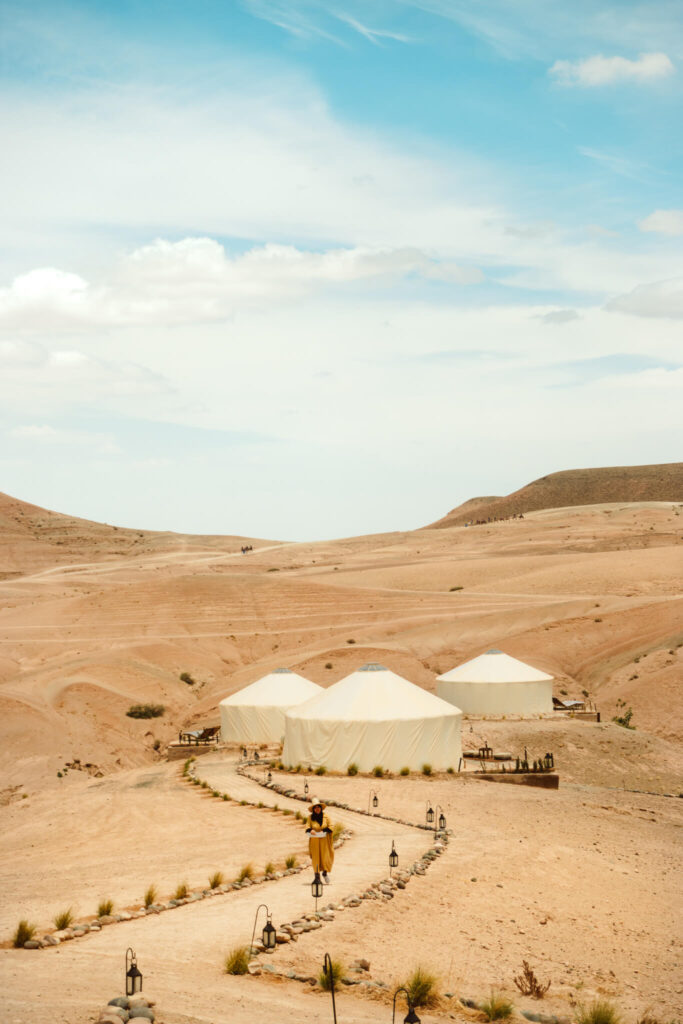
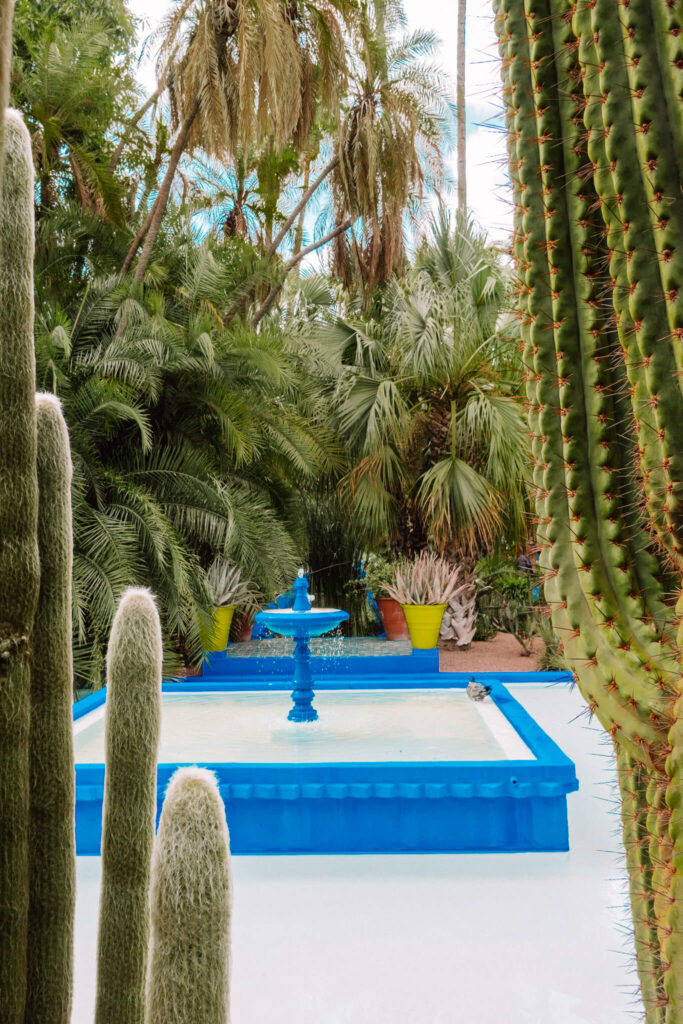
Best Time to Visit Marrakech
Marrakech has a semi-arid climate with hot summers and mild winters. And, it’s ideally situated near both mountains and deserts. So when you plan to visit depends a bit on what you’d like to do with 3 days in Marrakech, plus your ability to handle the heat! Let’s break it down by season:
Spring (March to May):
The spring is an excellent time to visit Marrakech as the weather is pretty mild with temperatures averaging 74 – 83°F. The flowers and greenery will be blooming, and the Atlas mountains may still be capped in snow. This is also peak tourist season so expect crowds and higher rates for hotels and flights.
Summer (June to August):
The summer months will be hot, hot, hot! Seriously, temperatures will be above 90°F and can even soar above 100°F. If you dare to brave the heat, make sure your lodging has air-conditioning and a pool — as it will definitely be pool lounging weather!
During the summer, an escape to the Atlas mountains can provide some relief from the heat and make for a great day trip.
Fall (September to November):
Similar to spring, the fall brings more mild temperatures and the tourists return for high season again. During peak seasons, you’ll want to book your lodging and flights in advance!
Winter (December to February):
Winter has the most mild daytime temperatures with highs around 63°F, but the evenings can be a little chilly with temperatures dropping as low as 43°F. The nearby Atlas mountains are usually covered in snow which can make for some scenic views, and this is a good time of year to visit the desert (while it’s not scorching!).
While there are fewer tourists during the winter months, the holidays can be a busy time for tourism as people take trips during their time off of work!
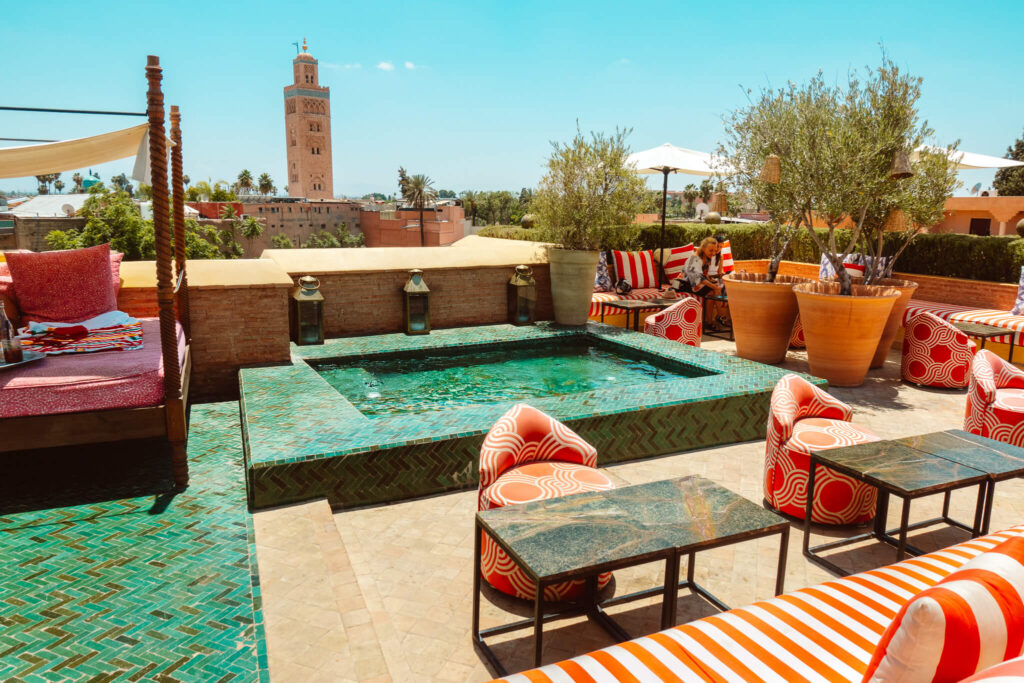
I visited Marrakech in early June which was the very beginning of the summer weather — we lucked out with temperatures in the 80s mostly! Plus, our riad was air-conditioned and had a rooftop pool.
Overall, we felt pretty comfortable while exploring during our 3 days in Marrakech and our trip to the Agafay desert was hot but the large pool at the desert camp was perfect for cooling down… More on that below!
As for crowds, it was definitely still crowded in early June. Many of the small riads were already booked up by the time we began planning and many of the main attractions were fairly busy. That being said, we made it work by starting our days early so it didn’t really detract from our overall trip!
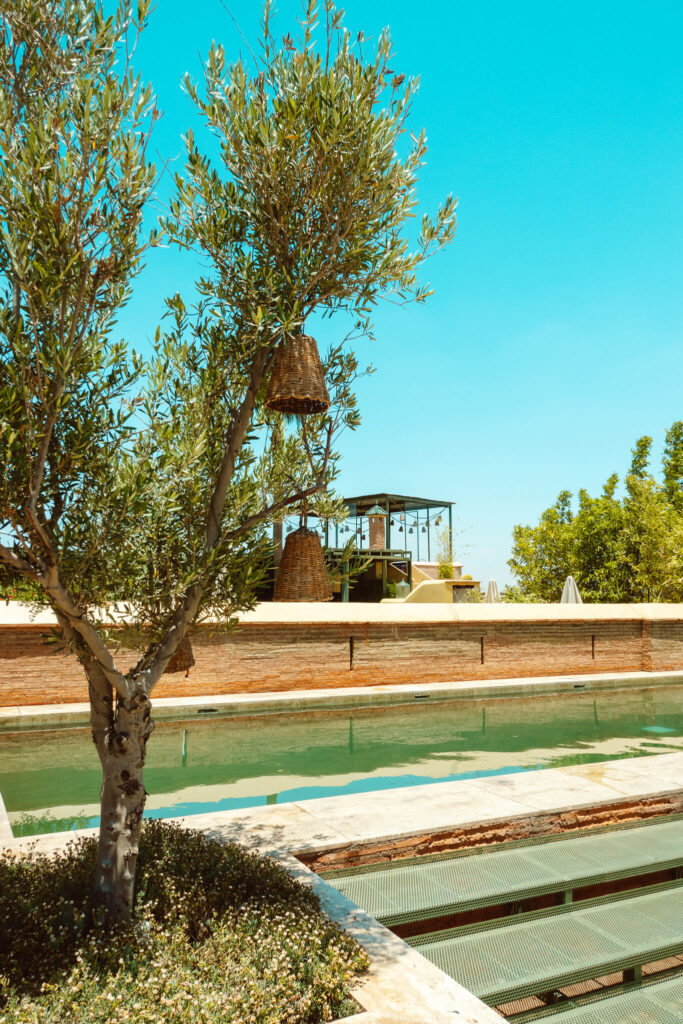
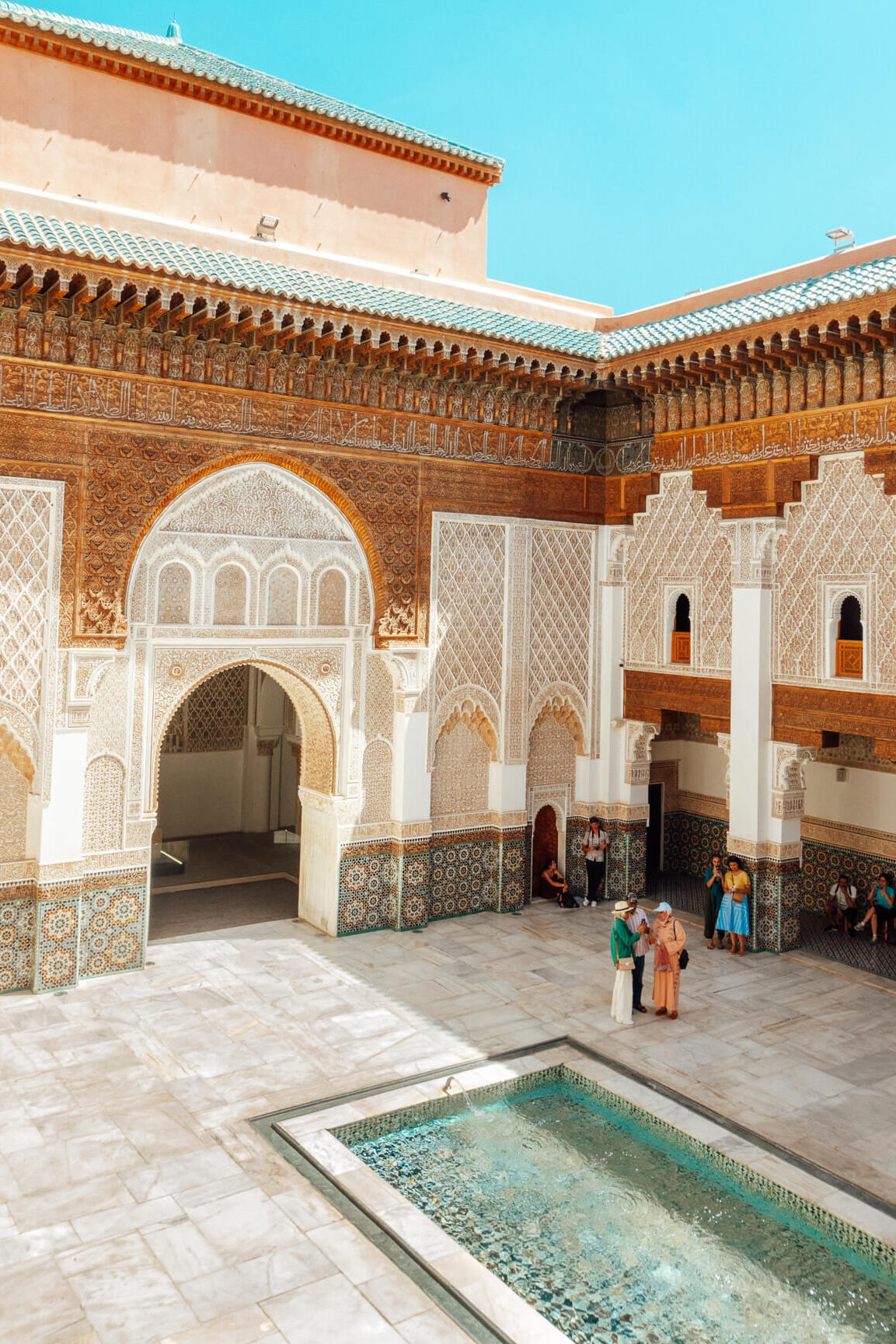
How to Get to Marrakech
As a popular tourist destination, Marrakech is well-connected by various means of transportation. The best way to get to Marrakech depends on your starting location! Here are some common ways to reach Marrakech:
By Air: If you’re coming from outside of Morocco, this is likely the mode of transportation you’ll take to get to Marrakech. Marrakech Menara Airport (RAK) is the main airport serving Marrakech, with direct international flights arriving from all over Europe. If you’re coming from the US, you’ll have to make a connection (most likely somewhere in Europe!).
By Train: Morocco’s national railway network, ONCF, operates train services connecting Marrakech to other major cities in Morocco, including Casablanca, Rabat, Fes, and Tangier. Train travel can be comfortable and convenient, providing an opportunity to see the Moroccan countryside during the journey.
By Bus: Several inter-city bus companies offer services connecting Marrakech with various cities in Morocco, providing a budget-friendly option for travelers. Also, CTM and Supratours are two well-known bus companies that operate comfortable and reliable services between Marrakech and other major cities.
By Car: Marrakech is accessible by road, and some travelers may prefer to rent a car for flexibility and to explore the surrounding areas. The road network in Morocco includes well-maintained highways that connect Marrakech to other major cities. However, if you plan to stay in the Medina, you’ll definitely need to find somewhere else to park your rental car or return it at the rental agency before heading into the city!
To get to Marrakech, I flew directly from Lisbon via TAP Air Portugal into Marrakech Menara Airport and it was a breezy 1.5 hour flight! Since we just stayed in Marrakech, I don’t have any personal experience with the train but I’ve heard it’s very convenient if you’re traveling to other cities in Morocco.
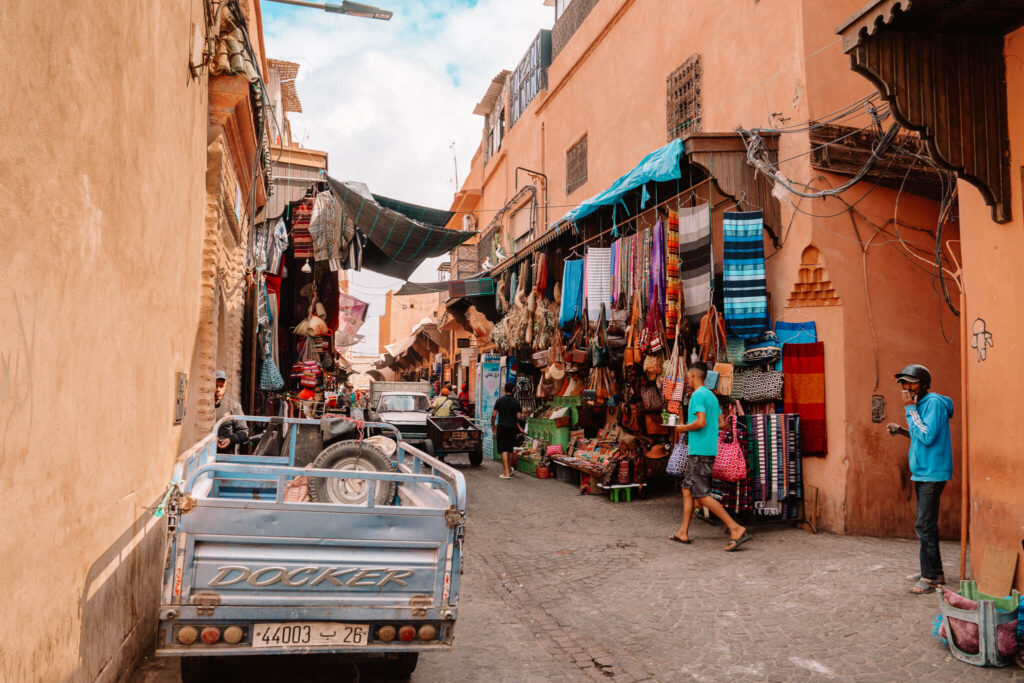
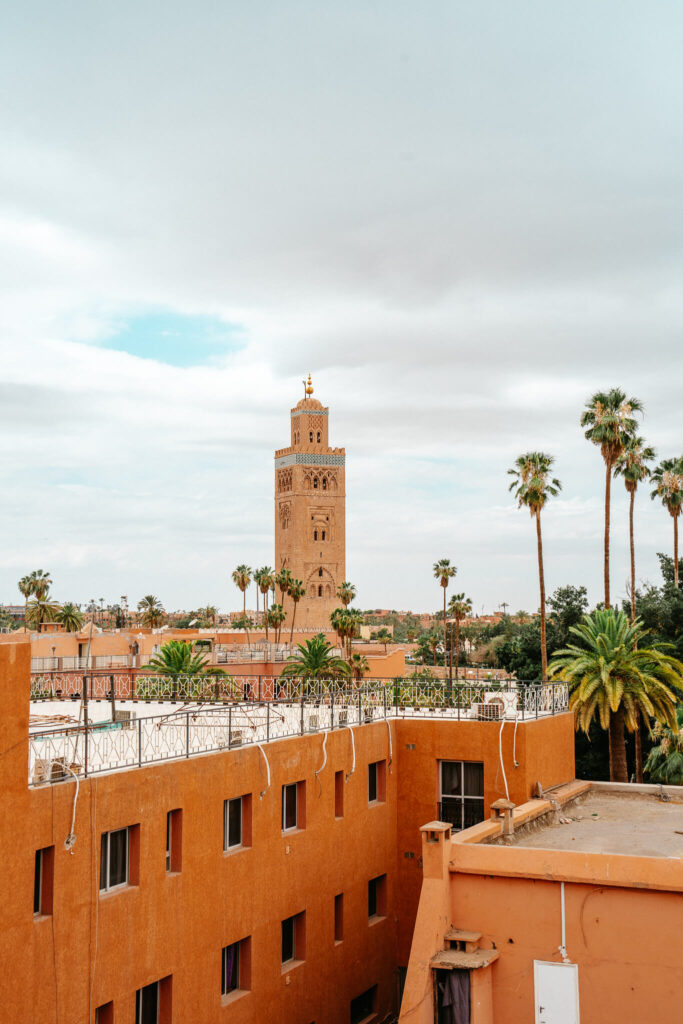
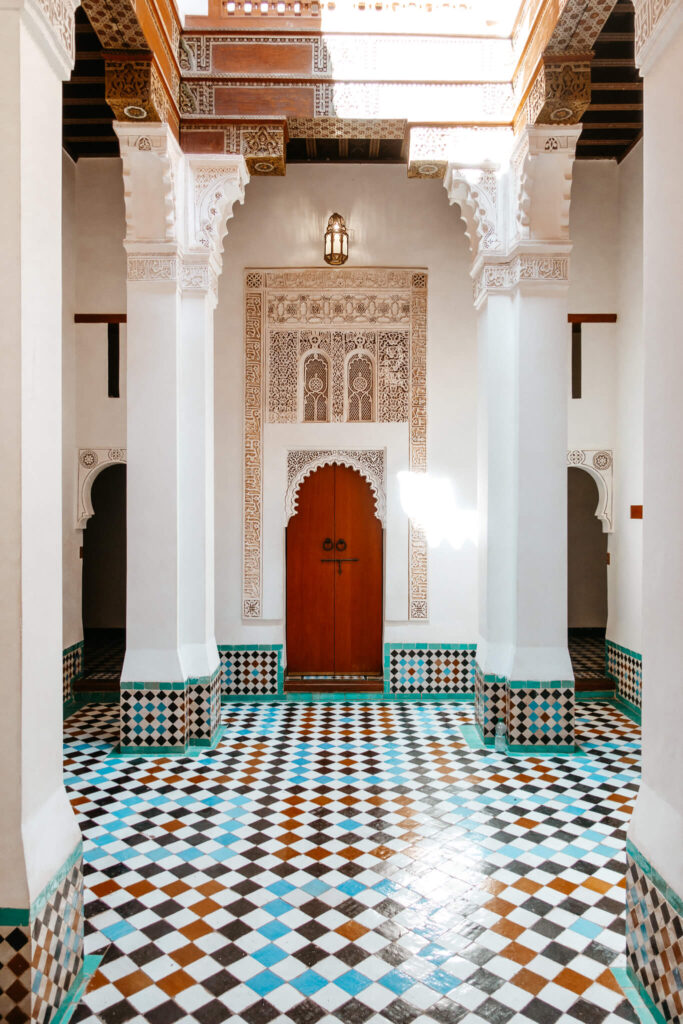
How to Get Around Marrakech
Getting around Marrakech is very doable on foot and by taxi. Here are some tips for how to navigate the city:
Walking: The old city’s narrow streets and vibrant markets are best explored on foot. Walking allows you to immerse yourself in the sights, sounds, and smells of Marrakech. Many of the city’s major attractions, such as Jemaa el-Fnaa square, Bahia Palace, and Koutoubia Mosque, are within walking distance of each other in the Medina. However, keep in mind that the winding, narrow streets can be very confusing and it can be easy to get lost.
I highly recommend downloading an offline map of the city on Google Maps as phone service is very spotty!
Quick tip: if locals try to give you directions or tell you to go a certain way, they will then usually expect money in return. I recommend to politely decline and follow your Google Maps directions!
Taxi: They are great for short distances outside of the Medina and can be hailed on the streets or found at taxi stands. Before beginning the ride, tell the driver where you would like to go and negotiate the fare, as some taxis might not use the meter.
Our riad was a bit tricky to find so one of the employees wrote down some directions (in Arabic) for the nearest street so we could show taxi drivers which turned out to be very helpful.
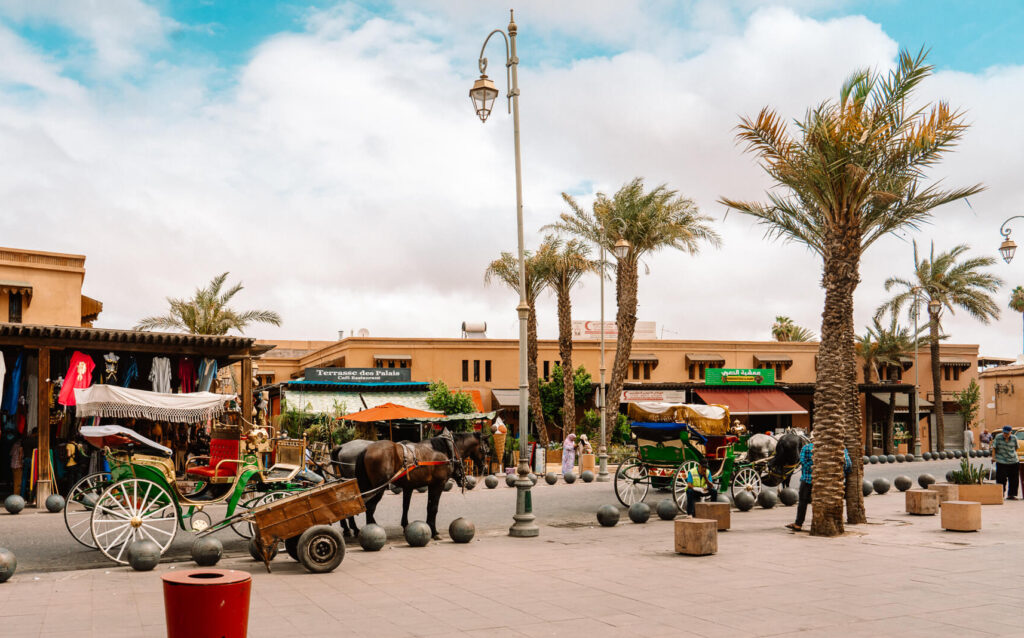
Horse-Drawn Carriage (Caleche): I noticed there were some horse-drawn carriages around the exterior of the Medina. However, I generally try to stay away from these wherever I go as I can’t be sure how the horses are treated.
Tuk Tuk: These three-wheeled, open-air vehicles can be hailed like a taxi within the Medina — as they can fit down the narrow streets (unlike regular taxis!). We noticed them mostly around Jemaa el-Fnaa square and we ended up taking one back to our riad after a long day of walking when we were totally exhausted! It was very convenient and affordable. Like with taxis, just make sure to negotiate the fare beforehand.
Private Cars or Tours: Hiring a private car or a driver can offer convenience and flexibility, especially for day trips or exploring areas outside Marrakech. We set up a private transfer through our riad to and from the airport, and also for our day trip to the Agafay desert.
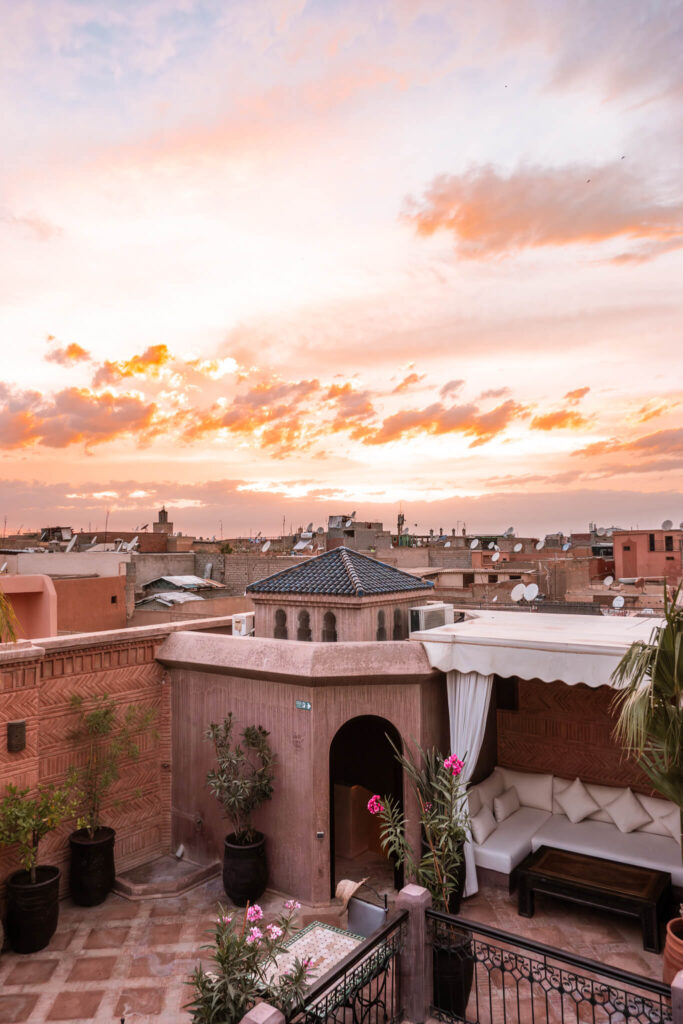
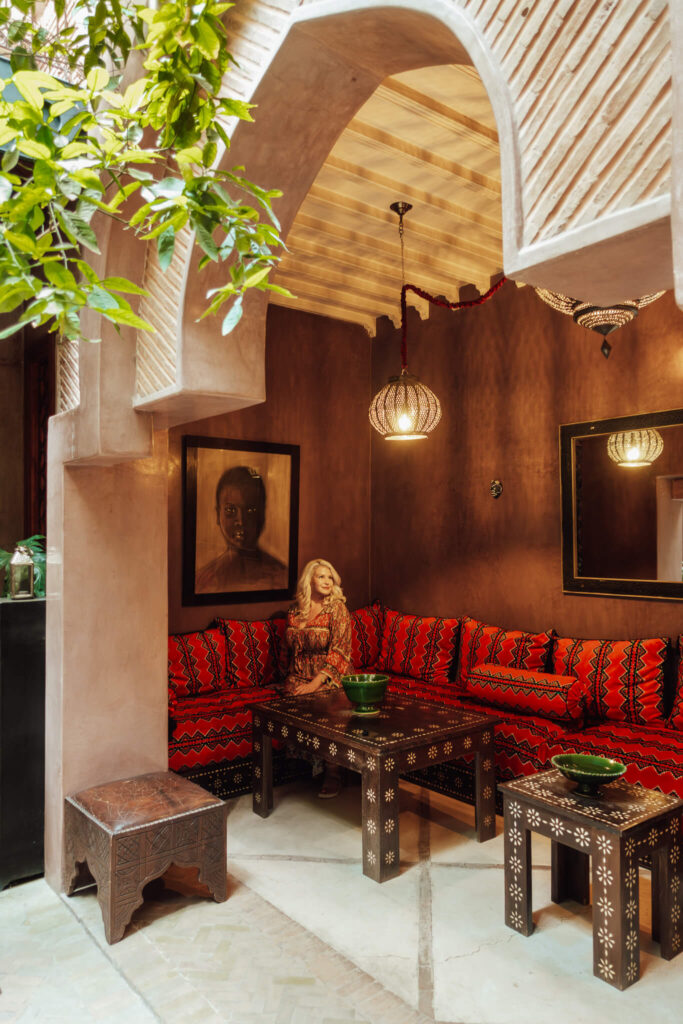
Important Information about Visiting Marrakech
Language: Arabic and French are the most widely spoken languages. But of course, English is also understood and spoken throughout the tourist areas! Learning some basic Arabic or French phrases or using translation apps can be helpful and polite.
Currency: The local currency is the Moroccan Dirham (MAD). I would definitely advise to have some cash for smaller transactions (like taxis, souvenirs, entrance fees, etc.), although credit cards are accepted in many establishments. We mostly used Moroccan Dirham but were able to use some Euros and even USD for shopping in the souk!
Visas: Travelers from many countries do not need a visa to visit Morocco for a period of up to 90 days. Citizens of the USA, Australia, New Zealand, the UK, the EU and Canada, among many others, do not need a visa to travel to Morocco, provided they have a passport of usually six months’ validity and an onward or return ticket (with supporting documents).
Haggling: Bargaining is common in the souks and markets. Practice your haggling skills but do so politely. I’ve heard that offering 1/3 of the original offer is a good place to start… But to be honest, I’m the worst at haggling!
Cultural and Social Etiquette: Morocco is a predominantly Muslim country with conservative customs. Dress modestly, especially when visiting religious sites or more traditional areas
Health and Safety: Drink bottled or filtered water to avoid stomach issues. Avoid tap water and be cautious with ice cubes in drinks. Be aware of pickpockets, especially in crowded areas like markets. Keep your belongings secure and be cautious with valuables.
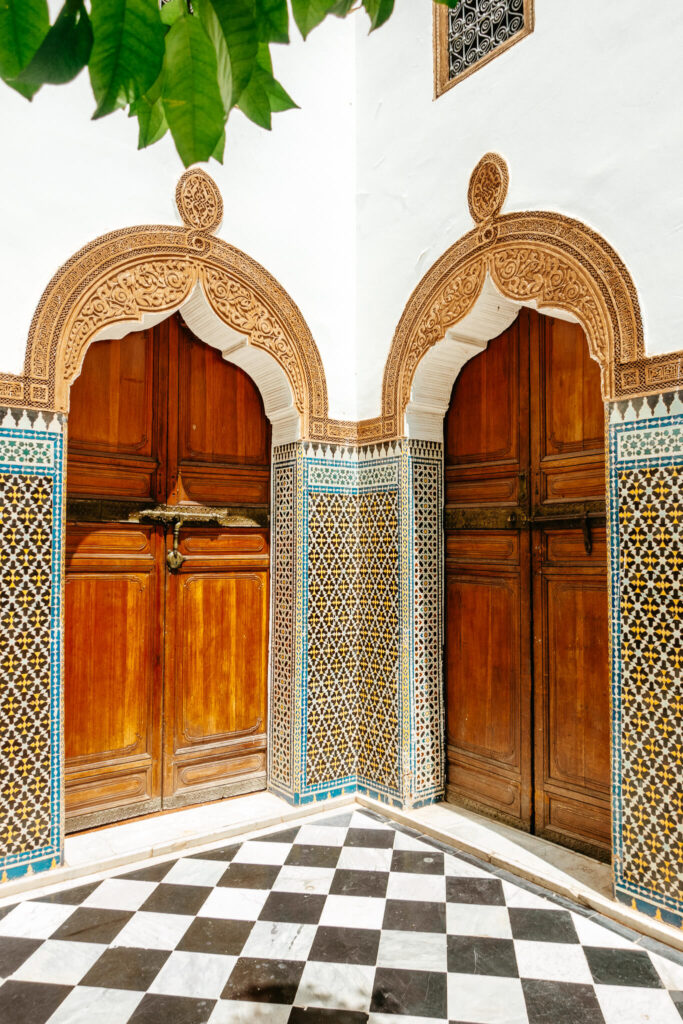
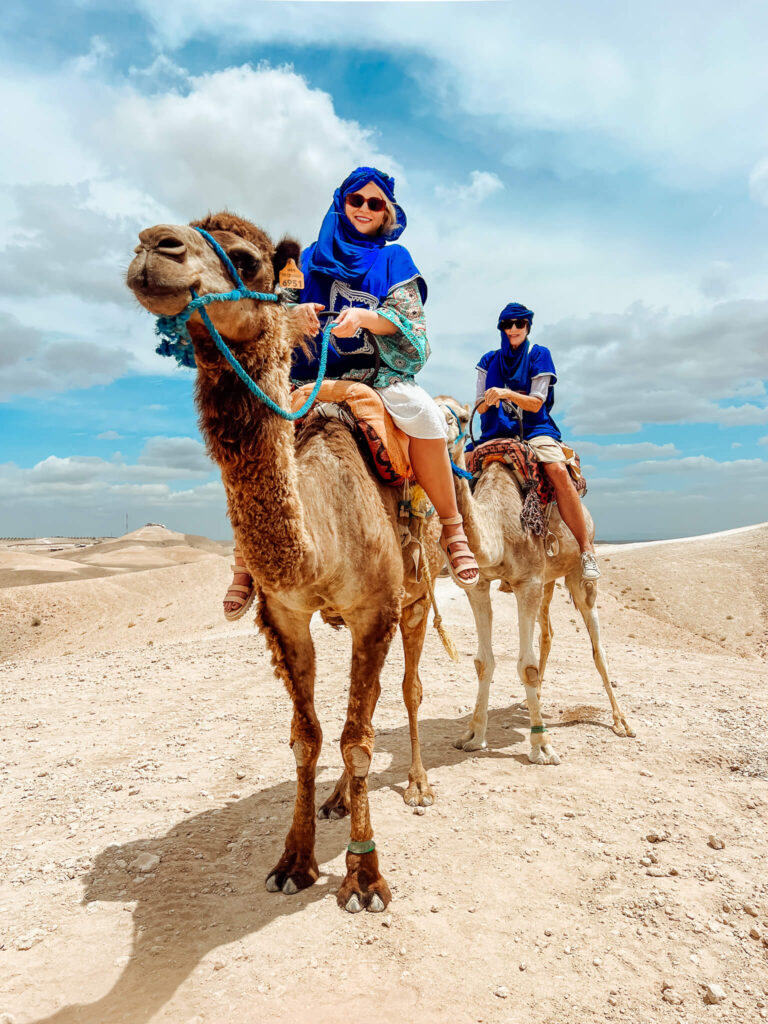
3 Days in Marrakech Itinerary
Here’s a quick overview of all the places visited on this 3 days in Marrakech itinerary:
Day 1: Explore the Medina — Bahia Palace, Jemaa el-Fnaa Square, Koutoubia Mosque, Souks, La Mamounia, Comptoir Darna
Day 2: Day Trip to the Agafay Desert
Day 3: Jardin Majorelle & Yves Saint Laurent Mansion, Museum of Confluences, Bacha Coffee, El Fenn, Ben Yousef Madrasa, La Salama
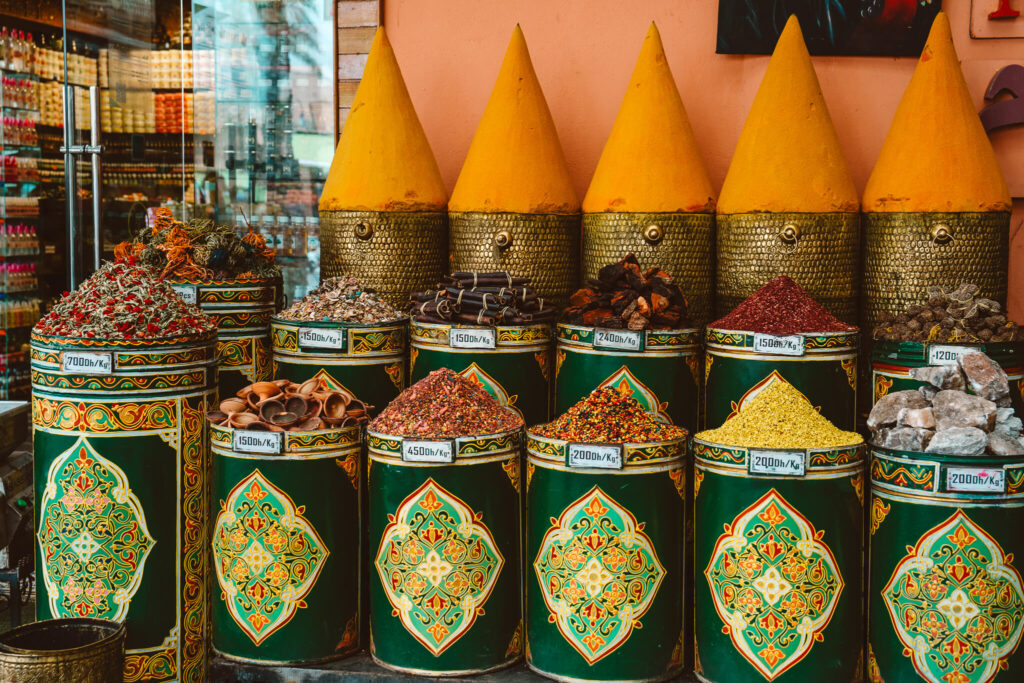
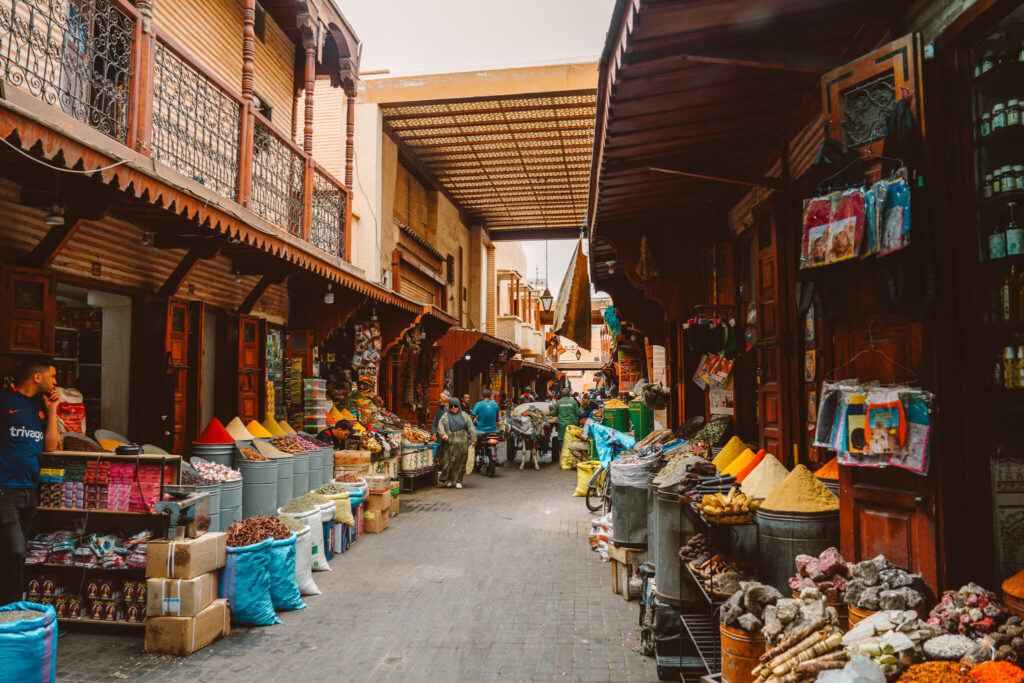
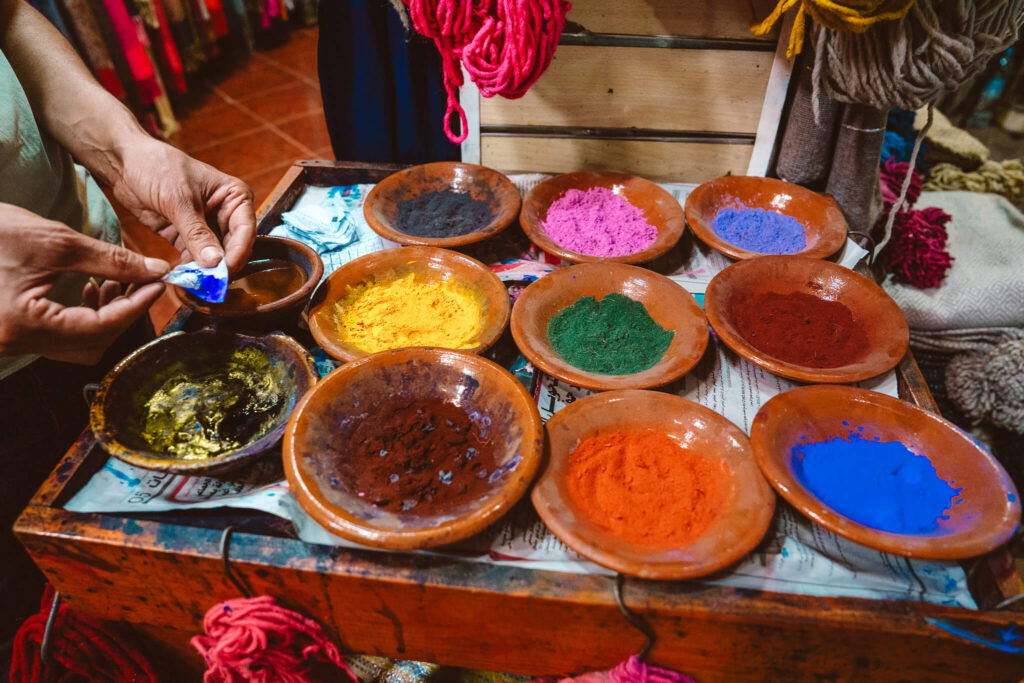
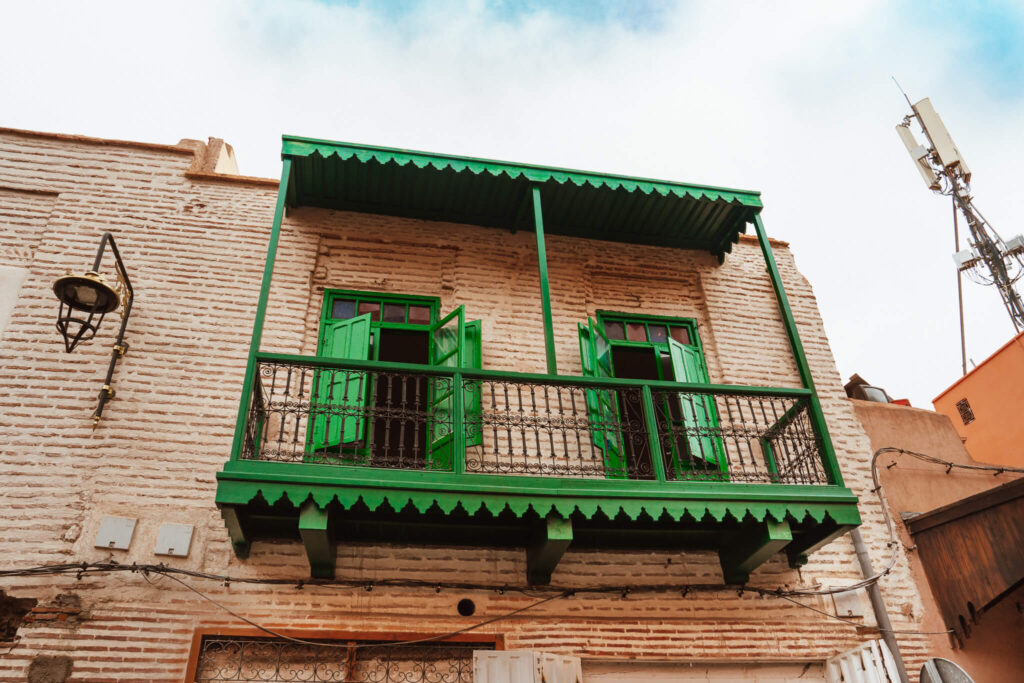
Day 1: Explore the Medina & Souks
For our first day in Marrakech, we wanted to explore the vibrant Medina and our riad set us up with a knowledgeable guide to show us some of the highlights — the guide cost was around $60 for the day.
The heart of Marrakech is its old city, the Medina, a UNESCO World Heritage Site filled with narrow winding streets, bustling markets, and historic sites.
We woke up early with our guide collecting us directly from our riad. Once we stepped out of our peaceful riad and onto the bustling streets of the Medina, we were very happy we decided to go with a guide on our first day. While you can definitely navigate the Medina on your own, it was helpful to have someone show us around while we got our bearings and acclimated to the sensory overload that is the exciting Medina!
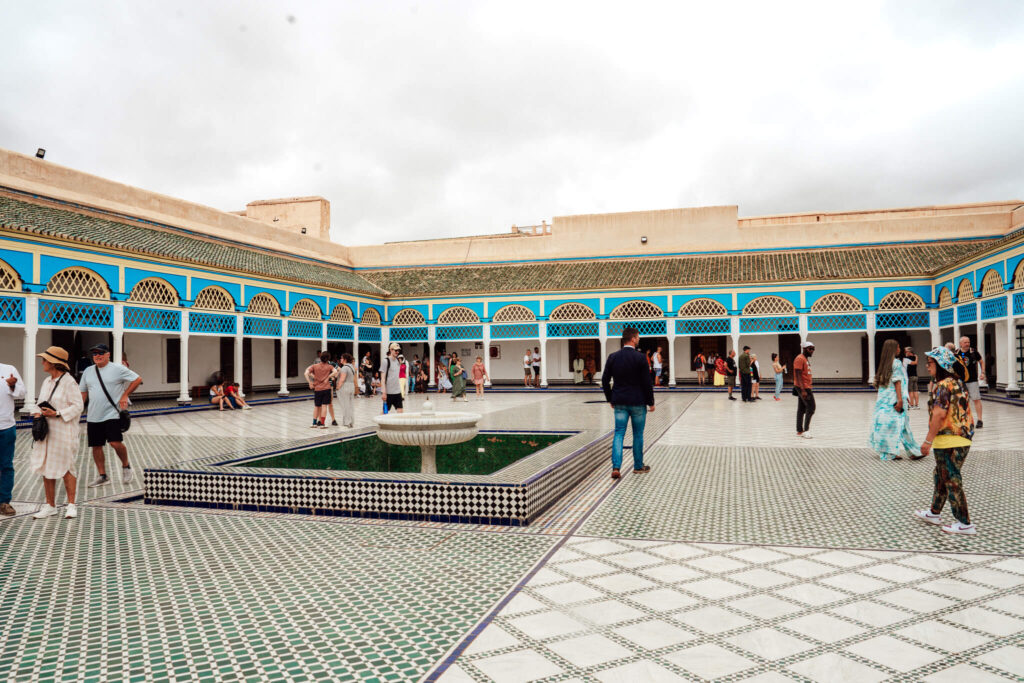
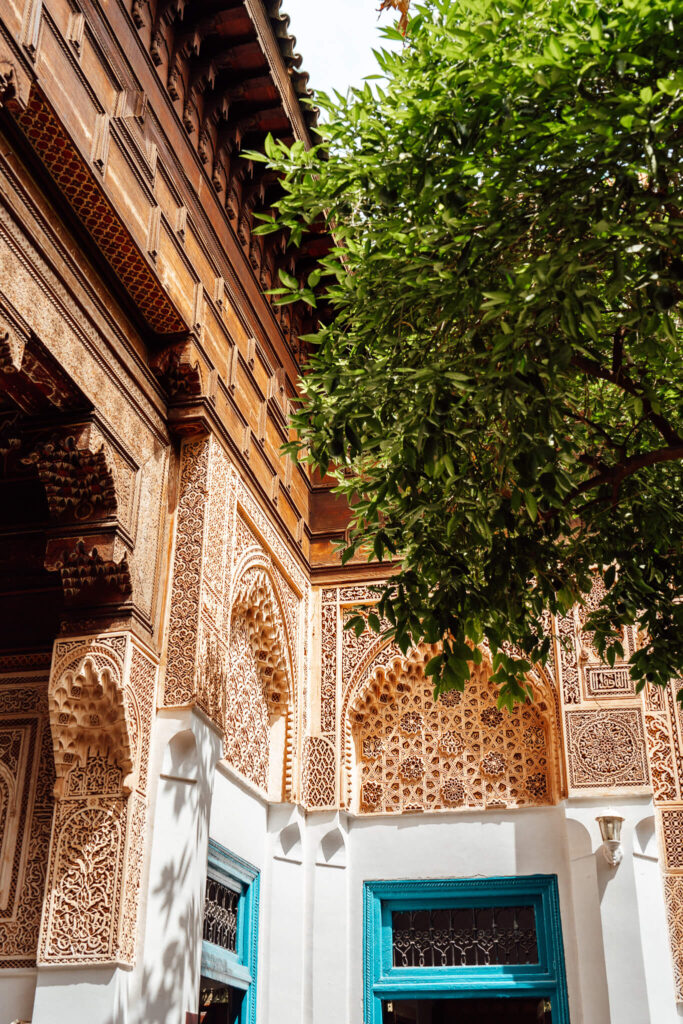
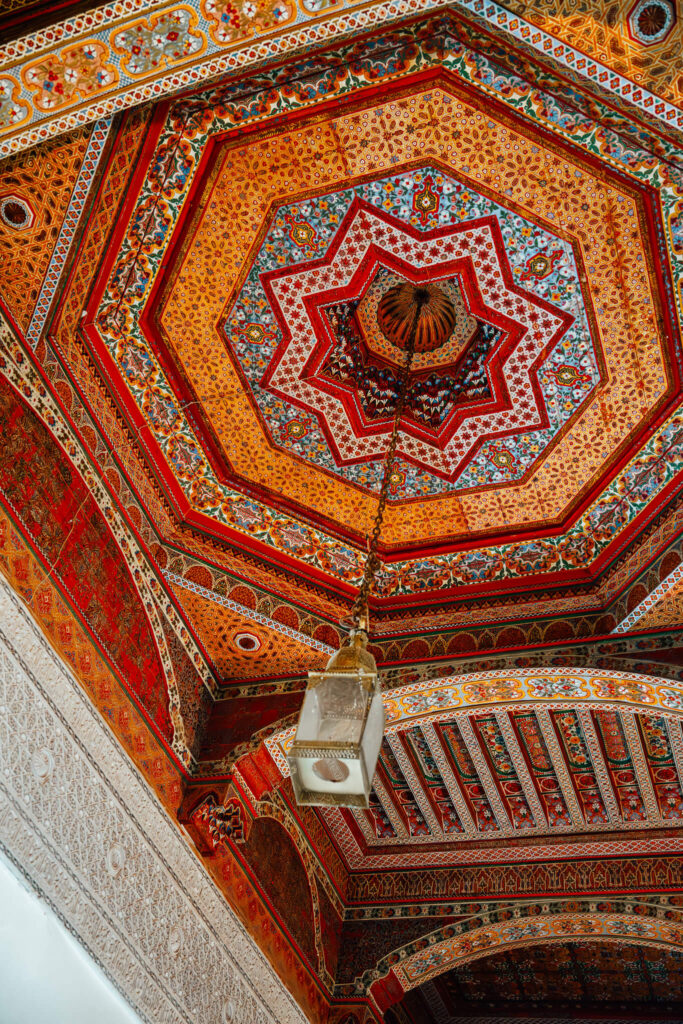
Bahia Palace
The Bahia Palace (or “Palais Bahia”) is a stunning historical palace located in the heart of the Medina. It’s renowned for its exquisite architecture, intricate design, and extensive gardens, and is one of the city’s most visited attractions.
It’s fascinating to get a glimpse into the opulent lifestyle of the historic elite in Marrakech!
The Bahia Palace was built in the late 19th century and is a complex consisting of a series of interconnected courtyards, gardens, and rooms. The expansive gardens are adorned with fountains, fragrant flowers, and citrus trees, offering a tranquil escape from the bustling city.
The palace is typically open to visitors daily, with an entrance fee. We paid 70 dirhams (around $7) per person and it was cash only so be sure to visit the ATM for some dirhams beforehand!
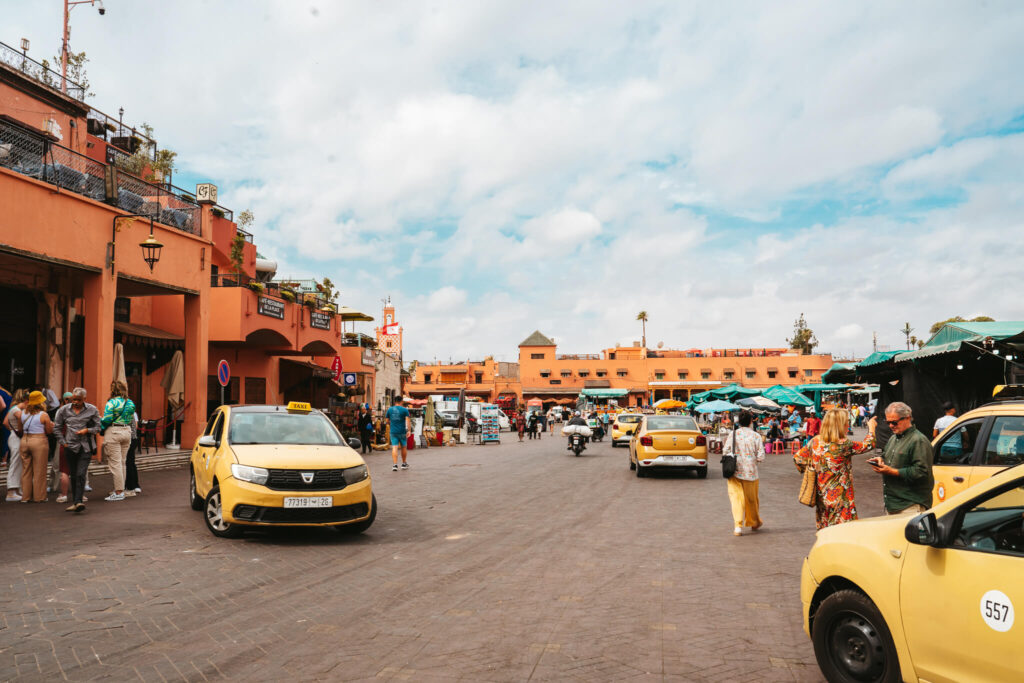
Jemaa el-Fnaa Square
This iconic square is the buzzing heart of the Medina, bustling with locals and tourists, food stalls, and a lively atmosphere day and night. It’s a UNESCO World Heritage Site and a central focal point of the city’s cultural and social life.
During the day and into the evening, Jemaa el-Fnaa Square comes alive with an array of street performers, including musicians, dancers, snake charmers, and storytellers, creating a lively and eclectic atmosphere.
As the sun sets, the square transforms into a vast open-air food market, offering a variety of Moroccan cuisine, including tagines, grilled meats, couscous, and traditional snacks. It’s a great place to experience local culinary delights.
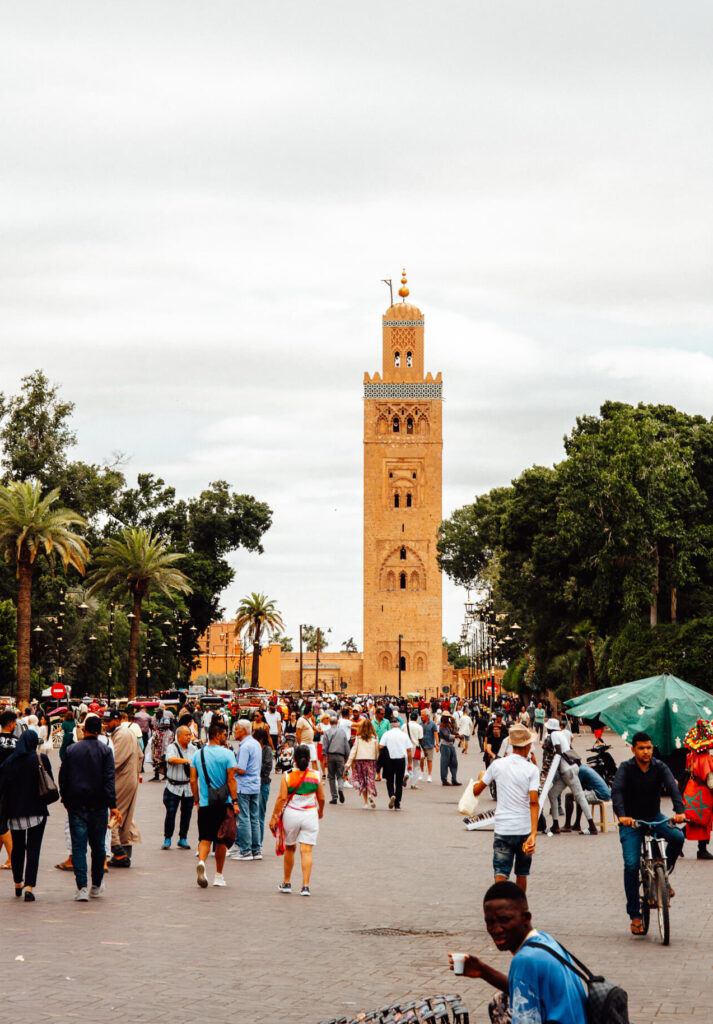
Koutoubia Mosque
Located just minutes from Jemaa el-Fnaa, Koutoubia Mosque is an iconic landmark and the city’s largest mosque. Built in the late 12th century, the mosque has a grand minaret that stands at over 250 feet tall and dominates the city’s skyline.
While non-Muslims cannot visit inside the mosque, it’s still impressive to admire the Moorish architecture from the outside!
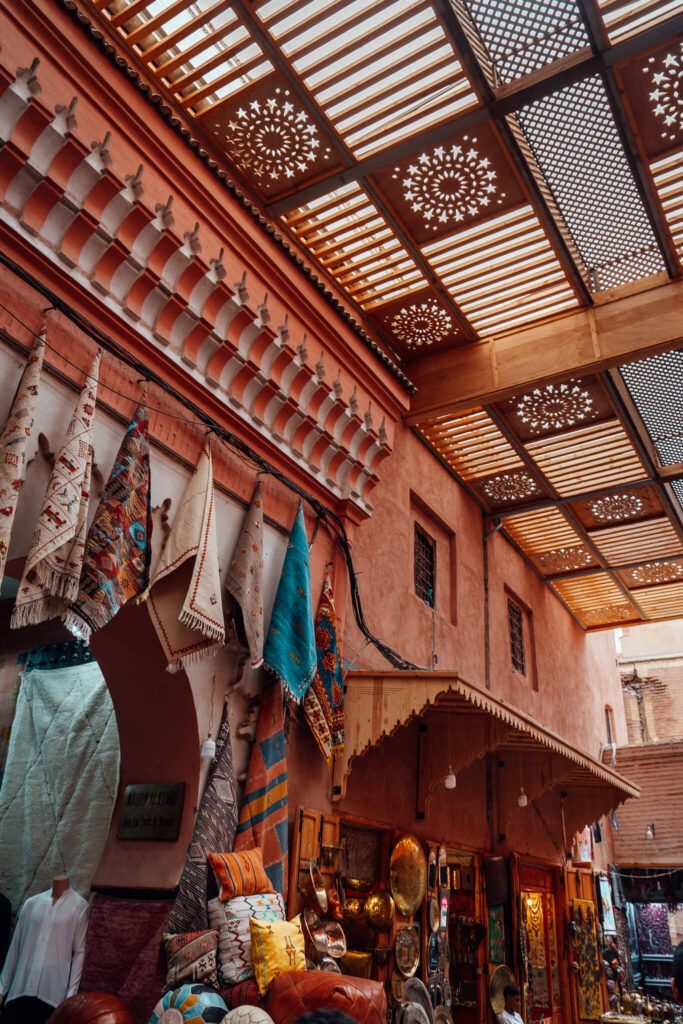
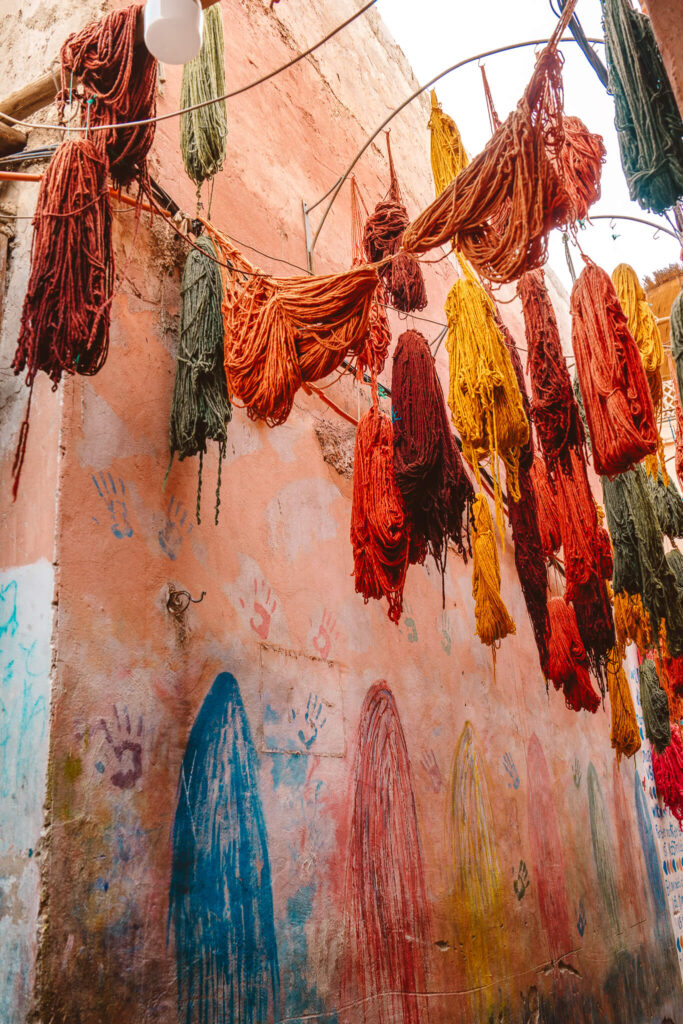
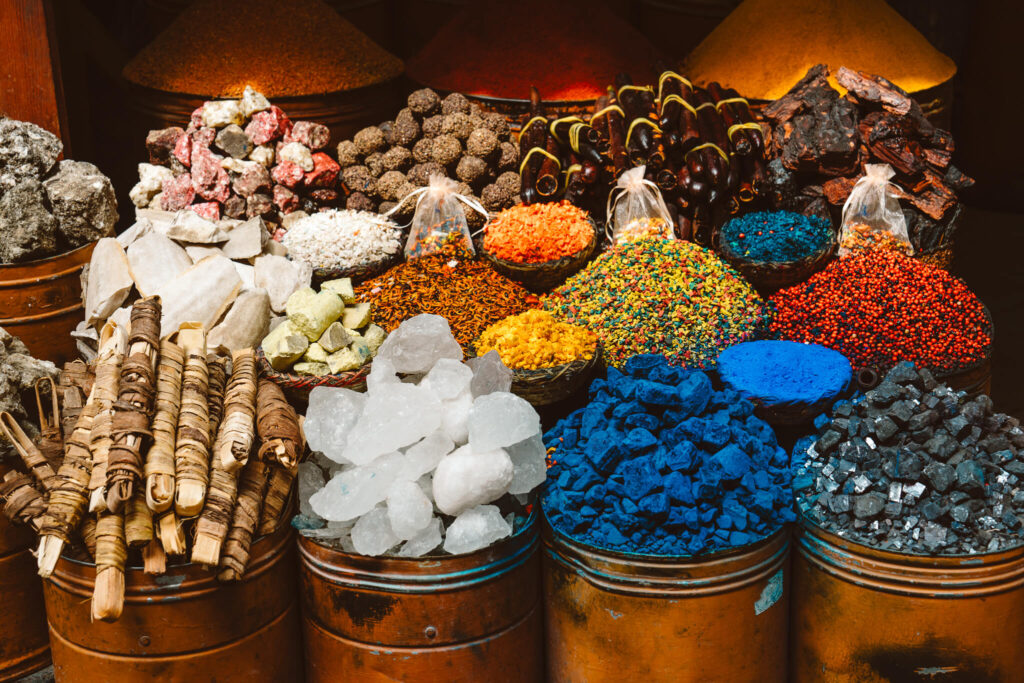
Explore the Souks
The souks in Marrakech are vibrant and bustling marketplaces that form an integral part of the city’s cultural and economic fabric. These traditional markets offer a sensory-rich experience, where visitors can immerse themselves in a maze of narrow alleyways filled with various goods, crafts, and local products.
I was very excited to experience the souks and do some shopping! While I was prepared for the types of goods to expect at the souks — spices and textiles to ceramics, leather goods, jewelry, and more — I didn’t realize that there was a different souk specializing in each good.
So for example, there was an entire souk specializing in leather goods with countless shops all selling different leather items. And an entire soak just for textiles, ceramics, and so on!
The labyrinthine layout of all these interconnected souks can be confusing, so this is where your map will come in handy to navigate the alleys. Or consider hiring a guide specifically to help you with shopping in the souks… I found it to be so helpful!
Note that cash is preferred in the souks, although some vendors might accept credit cards. And make sure to have small denominations of currency for easier transactions (and to help with haggling!).
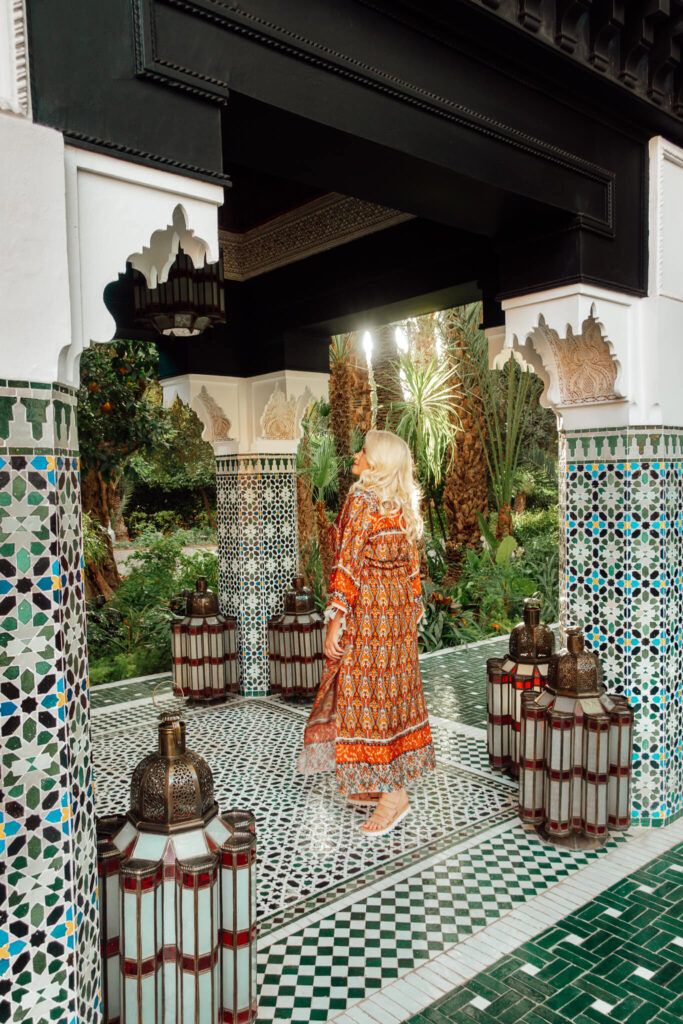
Drinks at La Mamounia
After our long day exploring the Medina, we returned to our riad to rest and get ready for dinner. Before our dinner, we decided to stop at La Mamounia for a pre-dinner cocktail.
La Mamounia is a renowned luxury hotel known for its opulence, elegance, and historical significance. It dates back to the 18th century when it was established as a royal palace. In 1923, the palace was converted into a hotel and opened its doors to guests. Over the years, it has welcomed numerous celebrities, dignitaries, and notable personalities.
Today, the luxury hotel is known for its luxe rooms, fine-dining restaurants, gorgeous spa and hammam, and expansive gardens.
Arriving at the hotel, I was struck by how grand and beautiful it was! I took some photos in the outside gazebo and was quickly approached by an angry employee who made me aware of a no photo rule and took me to the security office to lock up my camera until I left. I was very embarrassed and had no idea there was a rule against photos… so don’t be like me and make sure to follow the photography rules if you visit this hotel!
After the entrance, we were a bit frazzled and worried over my confiscated camera, so we decided to just have a quick cocktail at Le Bar Marjorelle and were on our way to dinner. I’ve heard that the gardens are very beautiful though so definitely check these out if you visit!
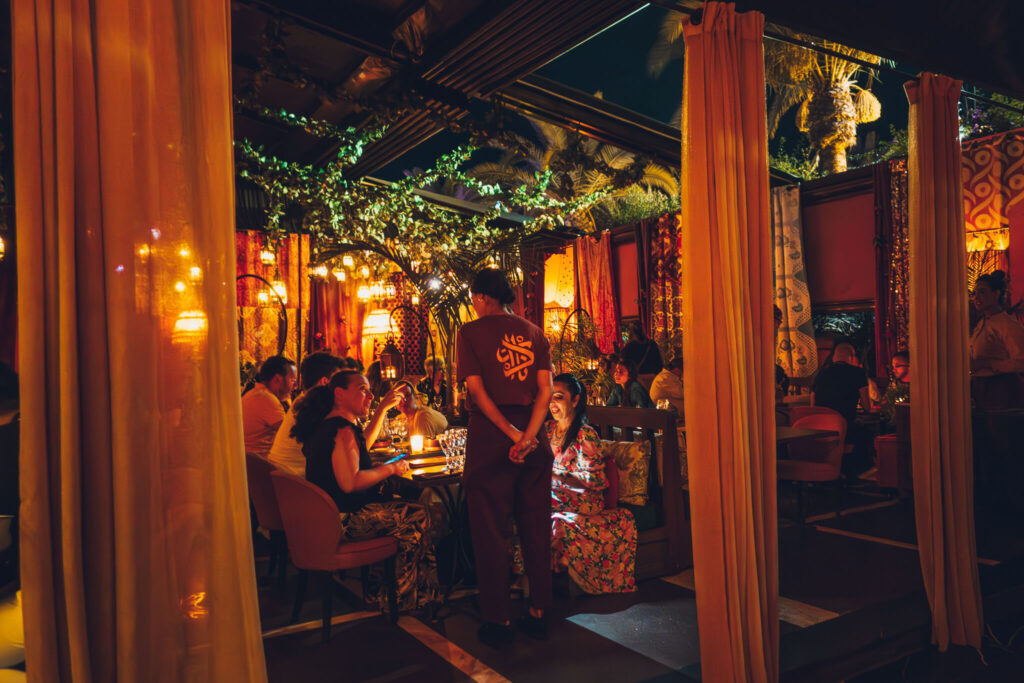
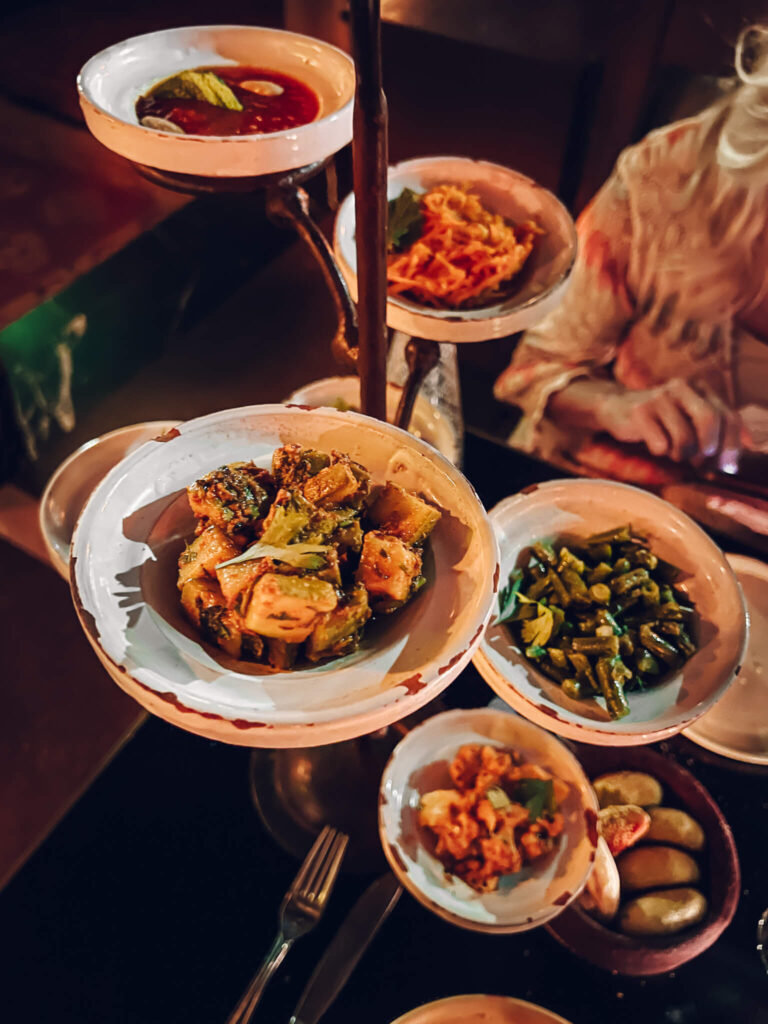
Dinner at Comptoir Darna
Comptoir Darna is one of the most popular restaurants in Marrakech and is known for its blend of Moroccan cuisine, entertainment, and lively atmosphere.
Since its such a popular spot, I made a reservation a few weeks in advance for 8:30pm as I read that there were two performances each night at 9:30pm and 11:15pm.
When we arrived, the restaurant was packed but we got a lovely table on the outdoor patio. We had an hour to begin enjoying our dinner before the entertainment started which was perfect.
We ordered the “7 Moroccan Salads” and the “Royal Couscous” and it was plenty of food for two people. All the food was delicious and it was fun to try so many different Moroccan specialities!
As we were finishing our dinner, we got to see the live belly dancing show. The dancers did a performance around the tables on the outdoor patio during dinner… It was a definitely an entertaining way to wrap up our meal at Comptoir Darna!
We left around 10pm and we noticed that the inside was beginning to have more of a lively nightclub vibe. So if you’re looking for a fun night spot, I would plan to visit Comptoir Darna on the later end and see the 11:15pm show!
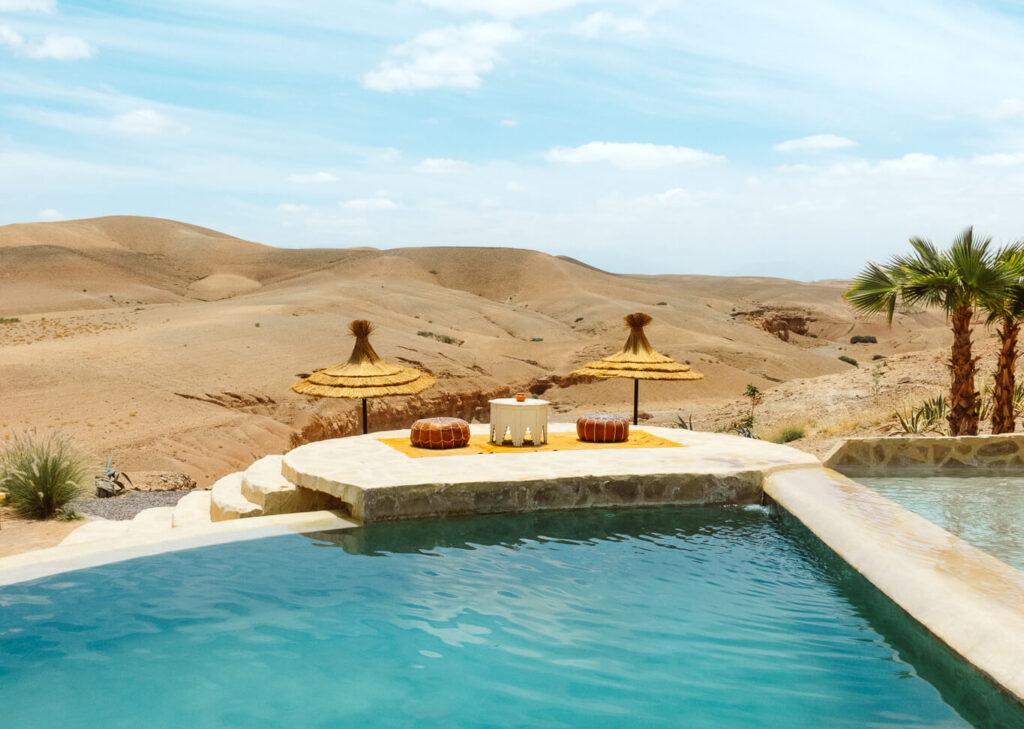
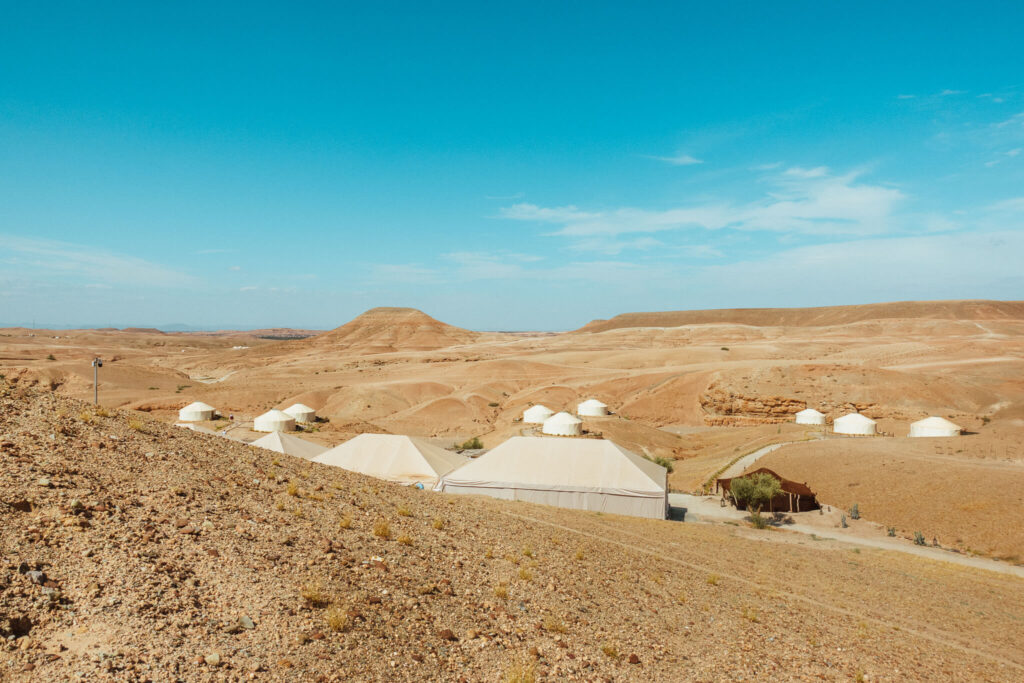
Day 2: Day Trip to the Agafay Desert
Morocco is known for its dramatic desert terrain, so I knew I wanted to include a day trip to the desert on my 3 days in Marrakech itinerary. While the Sahara Desert is absolutely on my bucket list, I knew it wouldn’t be possible with just 3 days in Marrakech since you need at least 2-3 days to visit it. A popular alternative is the Agafay Desert which is just under an hour from Marrakech!
The Agafay Desert is a unique and picturesque desert landscape characterized by vast barren plains, rocky terrain, and occasional sand dunes, offering a different experience compared to the traditional sand dunes of the Sahara Desert.
It’s an important distinction as you’ll be a bit disappointed if you visit the Agafay Desert expecting the iconic sand dunes of the Sahara!
However, the Agafay Desert is still very beautiful and much closer — so it’s doable on a day trip from Marrakech.
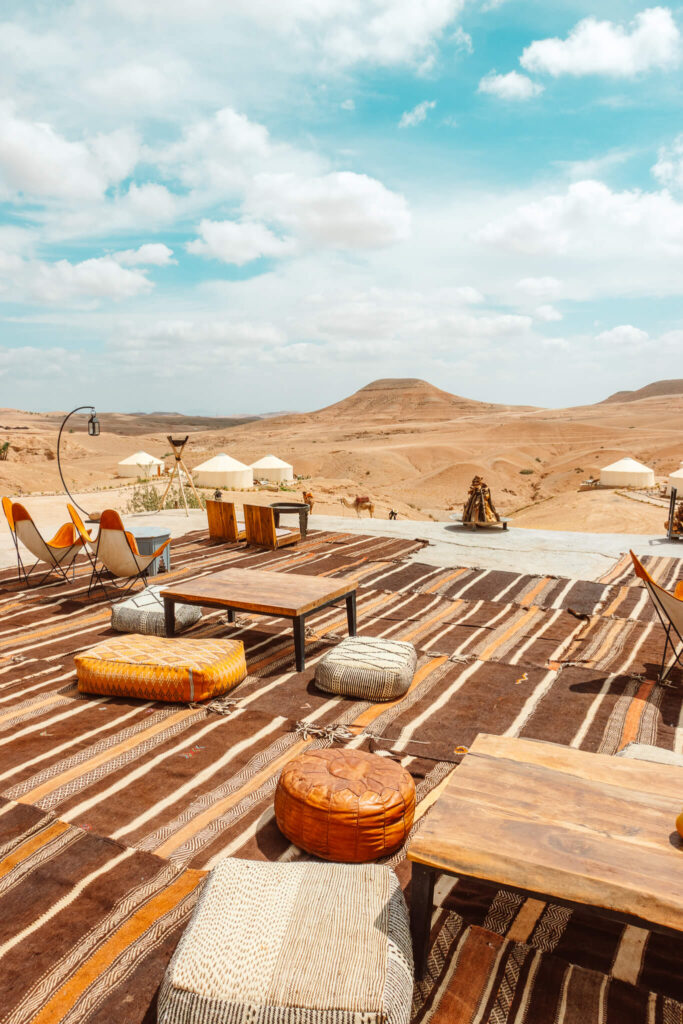
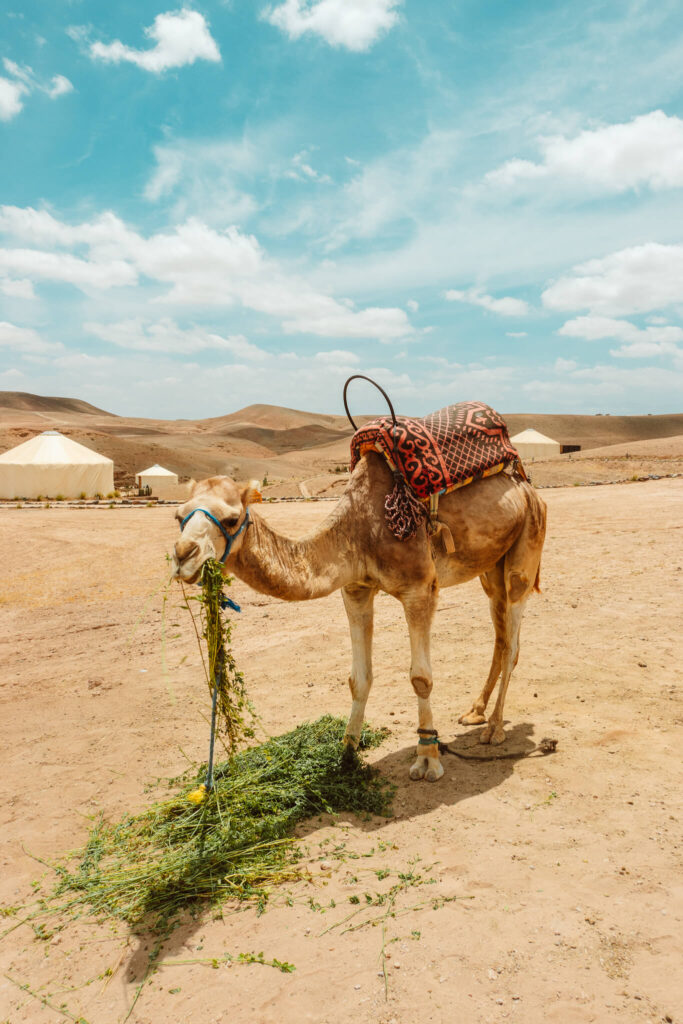
Best Things to do in the Agafay Desert
Desert Excursions: There are a lot of different activities available on tours — like camel rides, quad biking, horseback riding, and off-road vehicle tours, allowing visitors to explore the rugged terrain and experience the desert environment.
Sunset and Stargazing: The Agafay Desert is known for its breathtaking sunsets. Many tour operators offer sunset excursions, providing an opportunity to witness the changing colors of the sky over the desert. Additionally, the absence of city lights makes it an ideal spot for stargazing on clear nights!
Luxury Camps: There are luxury desert camps and accommodations in the Agafay Desert that offer a unique glamping experience. These camps feature comfortable tents, amenities, and traditional Moroccan hospitality, allowing guests to spend a night under the desert sky in style.
Cultural Activities: Some desert camps organize cultural activities such as traditional Berber music, dance performances, and Moroccan cuisine, providing a glimpse into local traditions and customs.
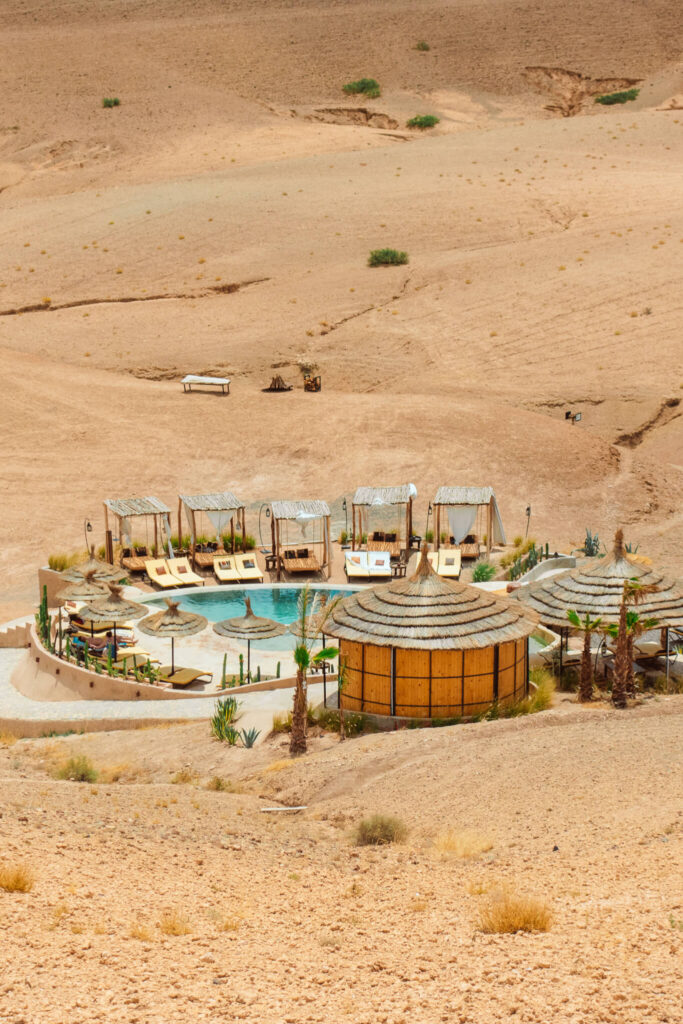
BE Agafay Luxury Camp
To visit the Agafay Desert, we decided to spend the day at one of the luxury desert camps in the area. BE Agafay is a camp that offers glamping-style lodging, as well as day passes to enjoy the restaurant, pool, and activities — like camel riding and quad biking.
We spent the day relaxing by the pool under the hot Moroccan sun, soaking in the panoramic desert views, and even did a quick guided camel ride around the hills surrounding the property!
→ Read Next: BE Agafay Luxury Camp — Everything You Need to Know!
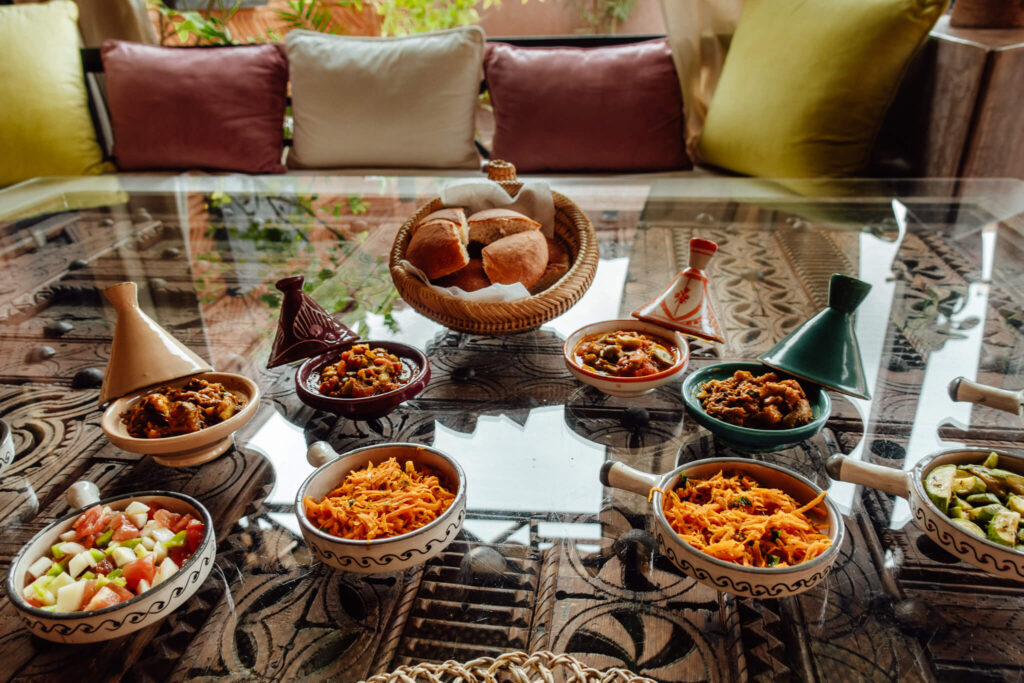
Dinner
After our day in the desert, we decided to enjoy dinner on the rooftop of our riad… Which was honestly some of the best food we enjoyed in Marrakech!
It was a feast of traditional Moroccan dishes, salads, and an incredible chicken tagine that I’m still dreaming about today.
Dar Yacout is another great dinner option offering traditional Moroccan dishes in an enchanting riad-like setting and is located in the heart of the Medina. Or, Dar Soukkar is a restaurant with a dazzling live show experience for a special night out!
Day 3: Visit the Famous Botanical Gardens, Palaces & Museums
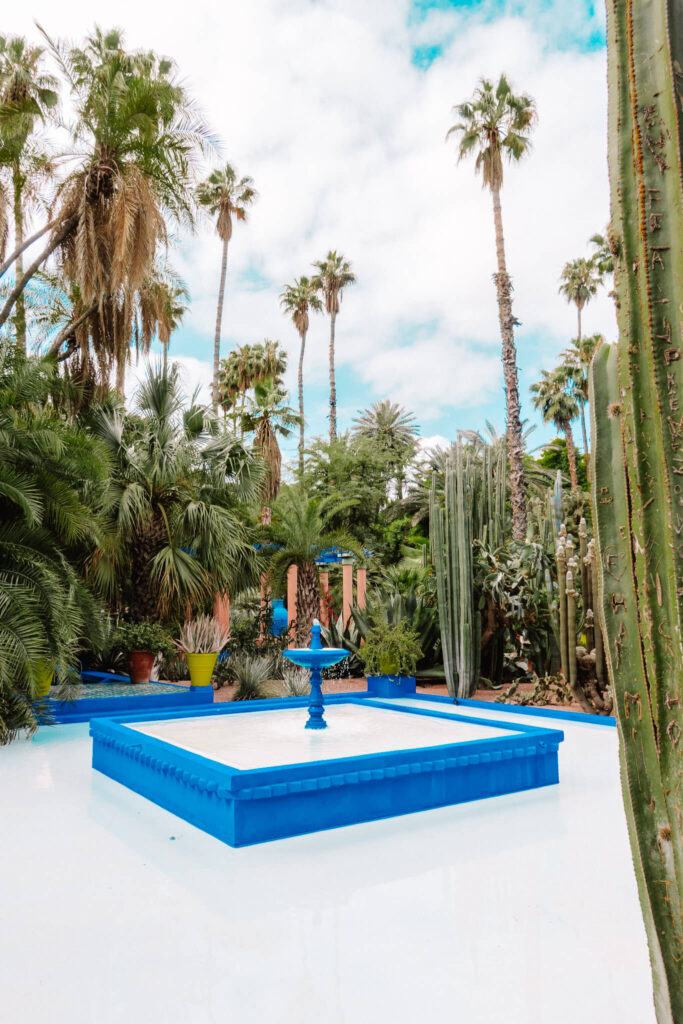
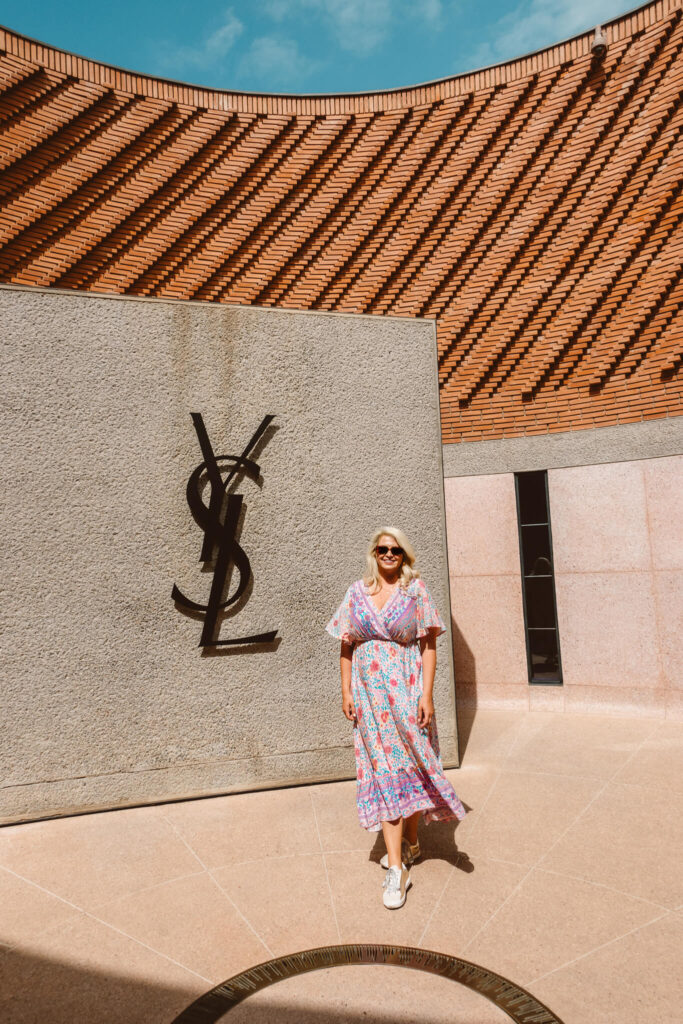
Jardin Majorelle & Yves Saint Laurent Mansion
One of the most popular attractions in the city and a must for your 3 day Marrakech itinerary is the Jardin Majorelle-Yves Saint Laurent Mansion.
Jardin Majorelle is a botanical garden known for its exotic plants, vibrant colors, and artistic legacy. It’s located in the Ville Nouvelle (New Town) area of Marrakech, not far from the Medina.
The garden was created by French painter Jacques Majorelle in the 1920s and 1930s. Then, in 1980, fashion icon Yves Saint Laurent and his partner Pierre Bergé acquired the garden to preserve its beauty and historical significance.
Since it’s such a popular attraction, we planned a visit for the first time slot in the morning — which still turned out to be very crowded! Despite the crowds, we enjoyed our stroll through the garden’s pathways, admiring the diverse plant species, and enjoying the serene ambiance.
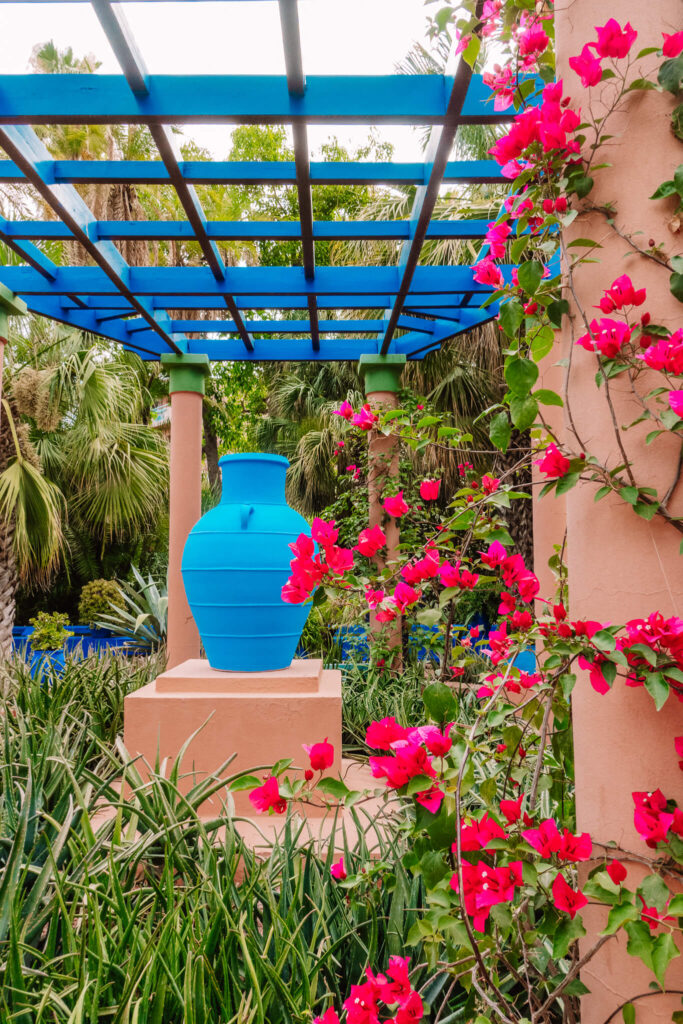
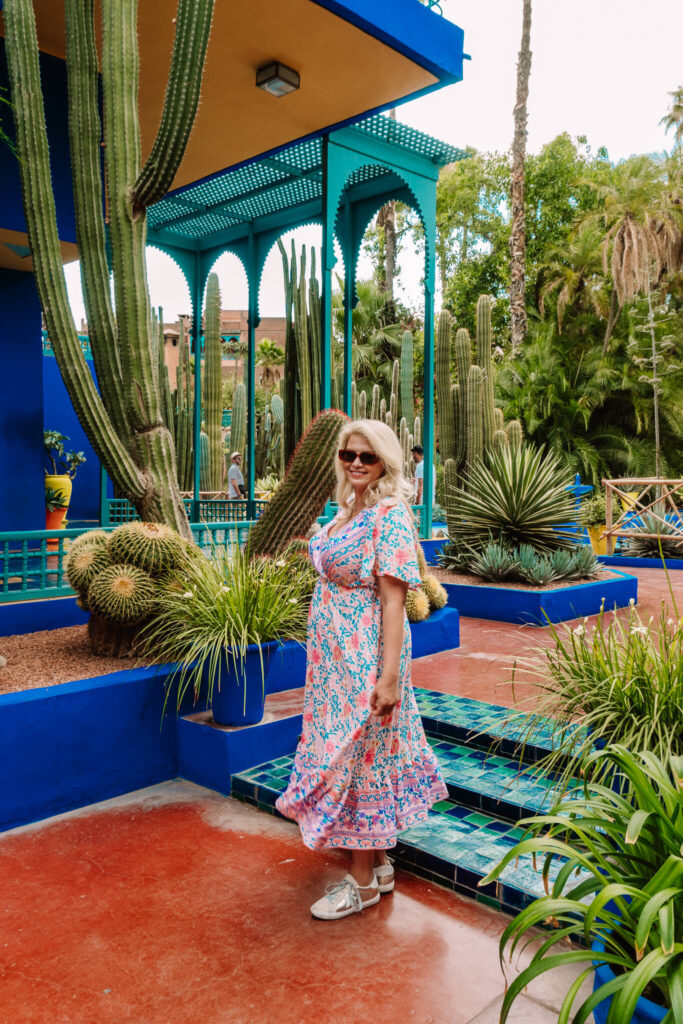
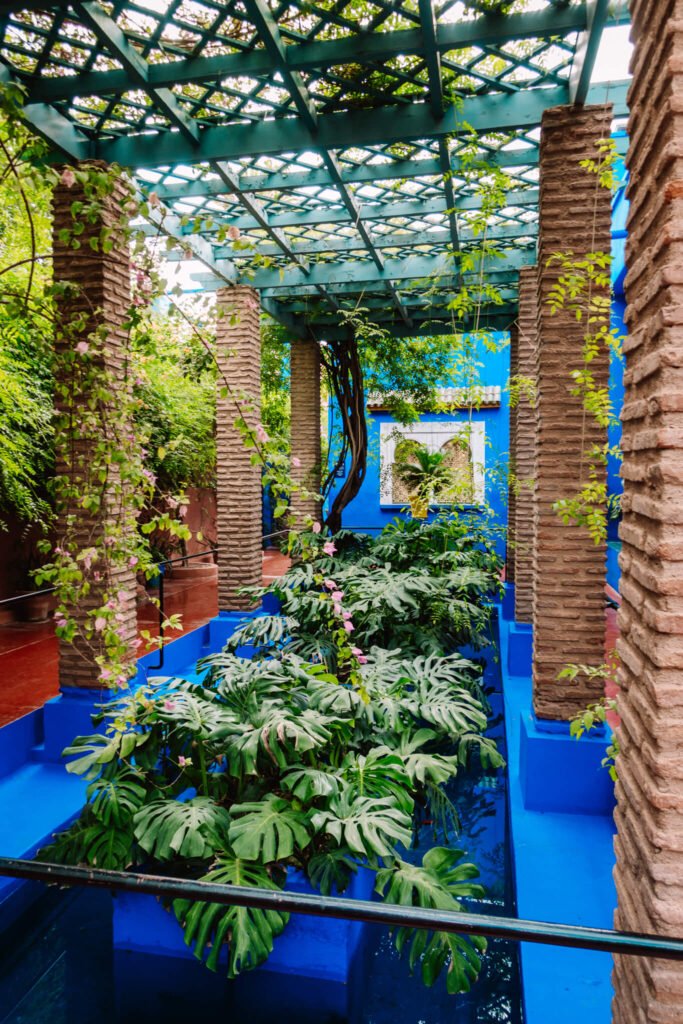
We purchased the combined ticket (for 315 MAD, or about $32 USD) so we were able to visit the Pierre Bergé Museum of Berber Arts and the Musée Yves Saint Laurent in addition to the Jardin Marjorelle. Note: tickets must be purchased online!
I really enjoyed the Pierre Bergé Museum of Berber Arts, which is inside the botanical garden. It was really fascinating to learn about the history of the Berber people and I loved seeing all the traditional outfits, jewelry and artifacts on display.
Finally, we visited the Musée Yves Saint Laurent — a museum dedicated to the fashion designer — which was located next door to the botanical gardens. And… it was surprisingly very uncrowded!
The museum building itself is quite architecturally stunning, while the interior is fairly small so you won’t need much time to see the whole exhibition. The exhibition features garments from Yves Saint Laurent’s collections as well as sketches, photos, and videos that showcase his design process.
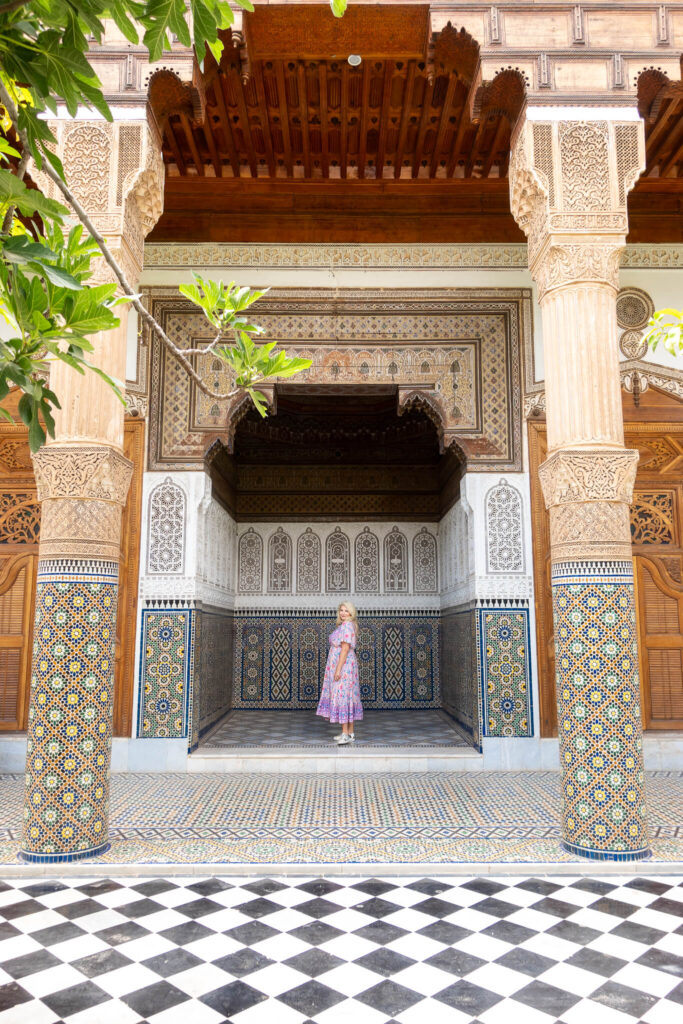
Museum of Confluences
Dar El Bacha is a historic 18th century palace located in the Medina and now houses the Museum of Confluences.
This museum features various exhibits, including displays of Moroccan textiles, ceramics, jewelry, traditional clothing, and historic objects that offer insights into the country’s cultural and artistic heritage. Also inside the Dar El Bacha palace is the famous Bacha Coffee (more on that in a bit).
We purchased tickets for 60 MAD (about $6 USD) to go inside the palace and visit the museum, as well as Bacha Coffee.
While quite small in size, I found some of the displays in the museum were really interesting and the palace itself is stunning and worth a visit alone! The palace features ornate details, a beautiful courtyard garden, and intricate tile work typical of Morocco.
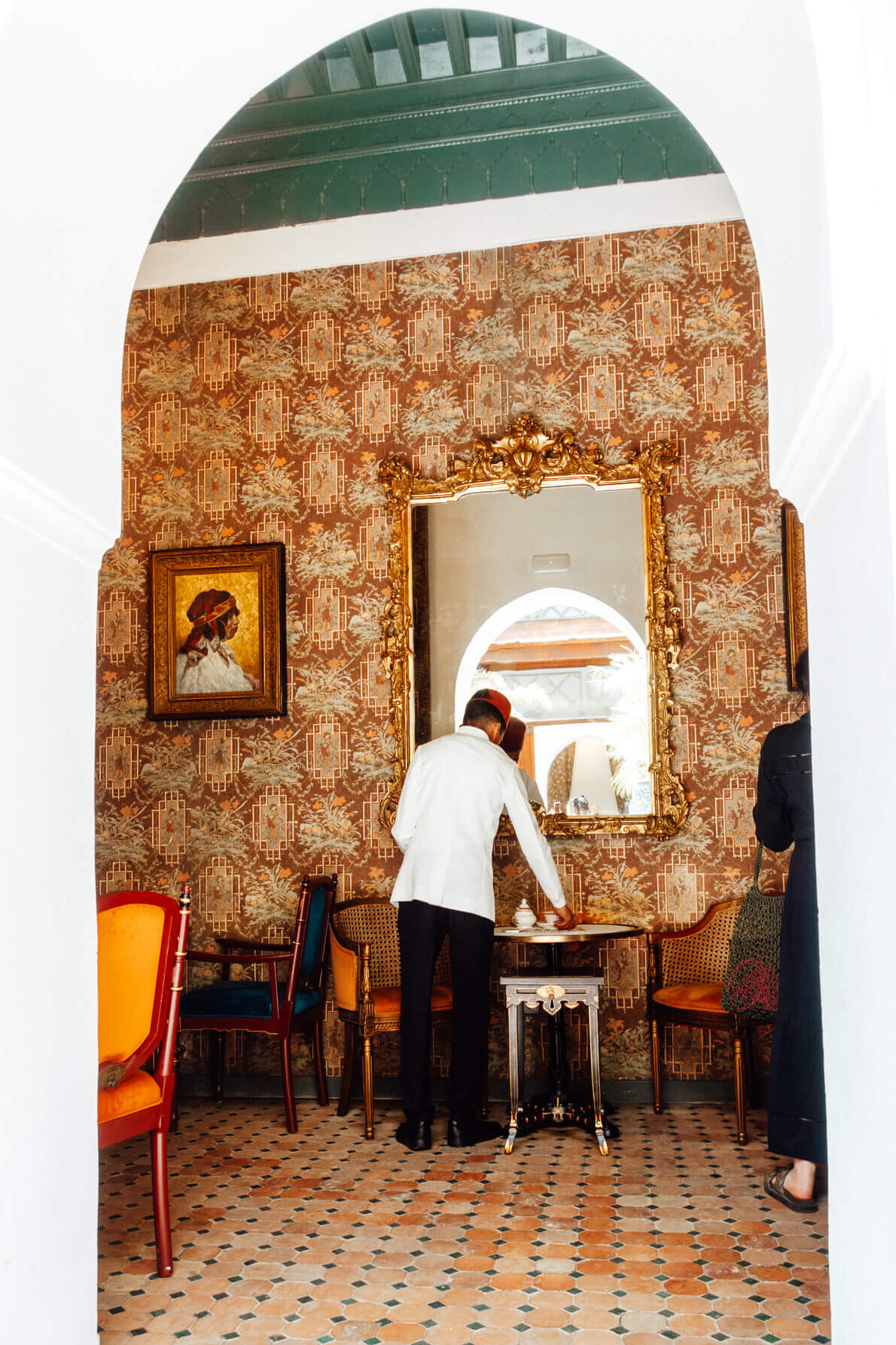
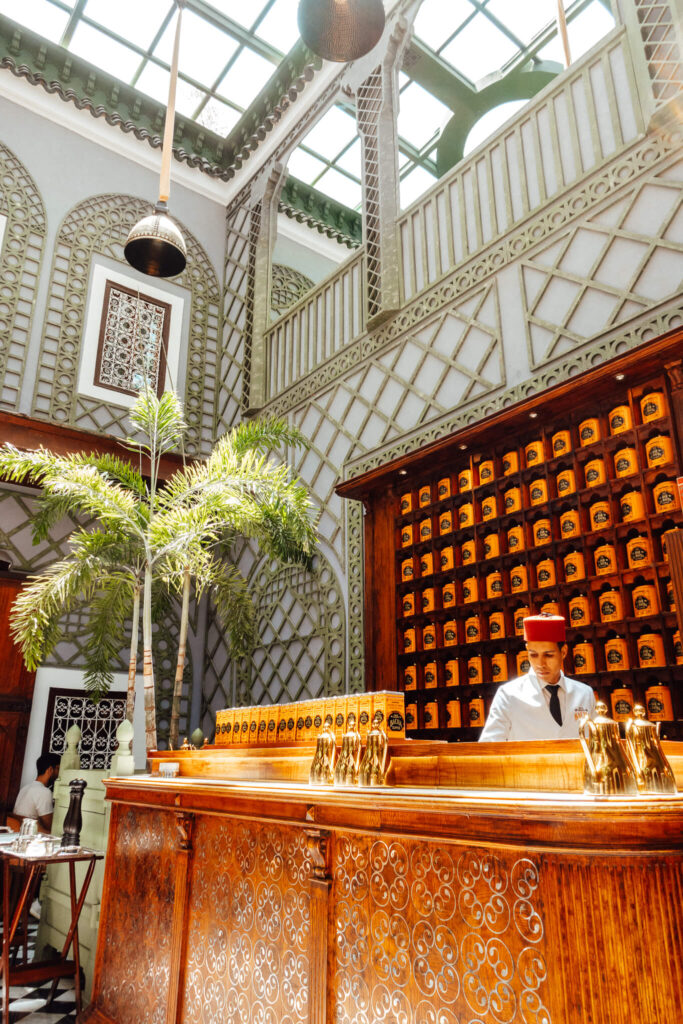
Bacha Coffee
The entrance to Bacha Coffee is tucked away in the corner of the courtyard of Dar El Bacha palace. But make no mistake, while it seems like it may be a hidden gem, it’s a very popular spot! In fact, we had to wait about 45 minutes to get seated — don’t worry though, the host gives you a buzzer that alerts you when your table is ready and you are then free to explore the museum until then.
Bacha Coffee is a small and glamorous coffee room where visitors can enjoy their world-renowned coffee and delicious pastries, tarts and cakes.
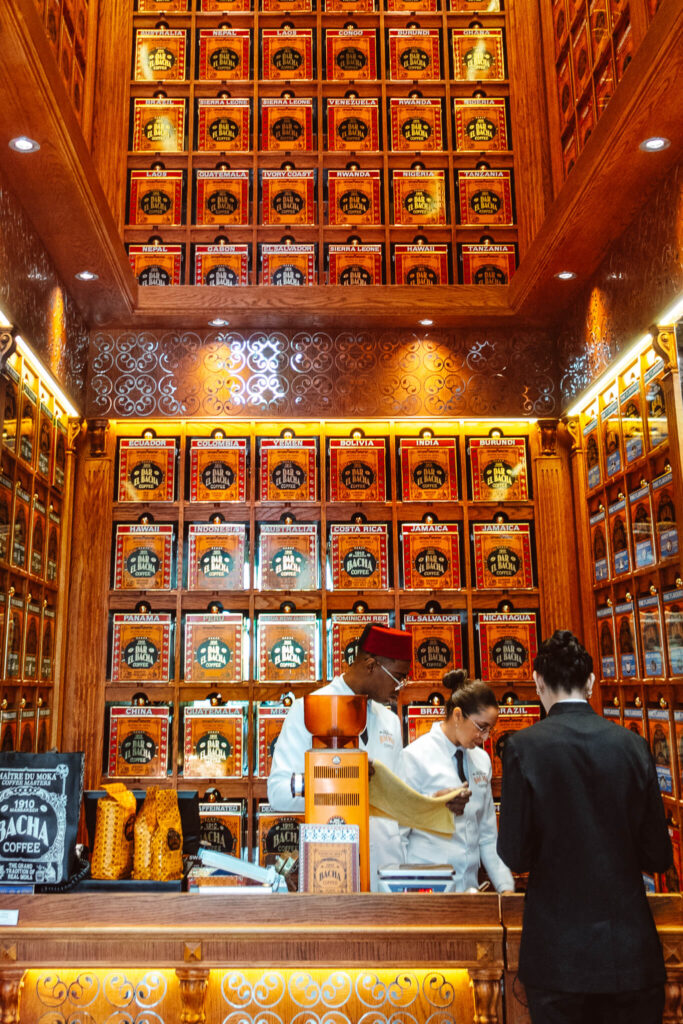
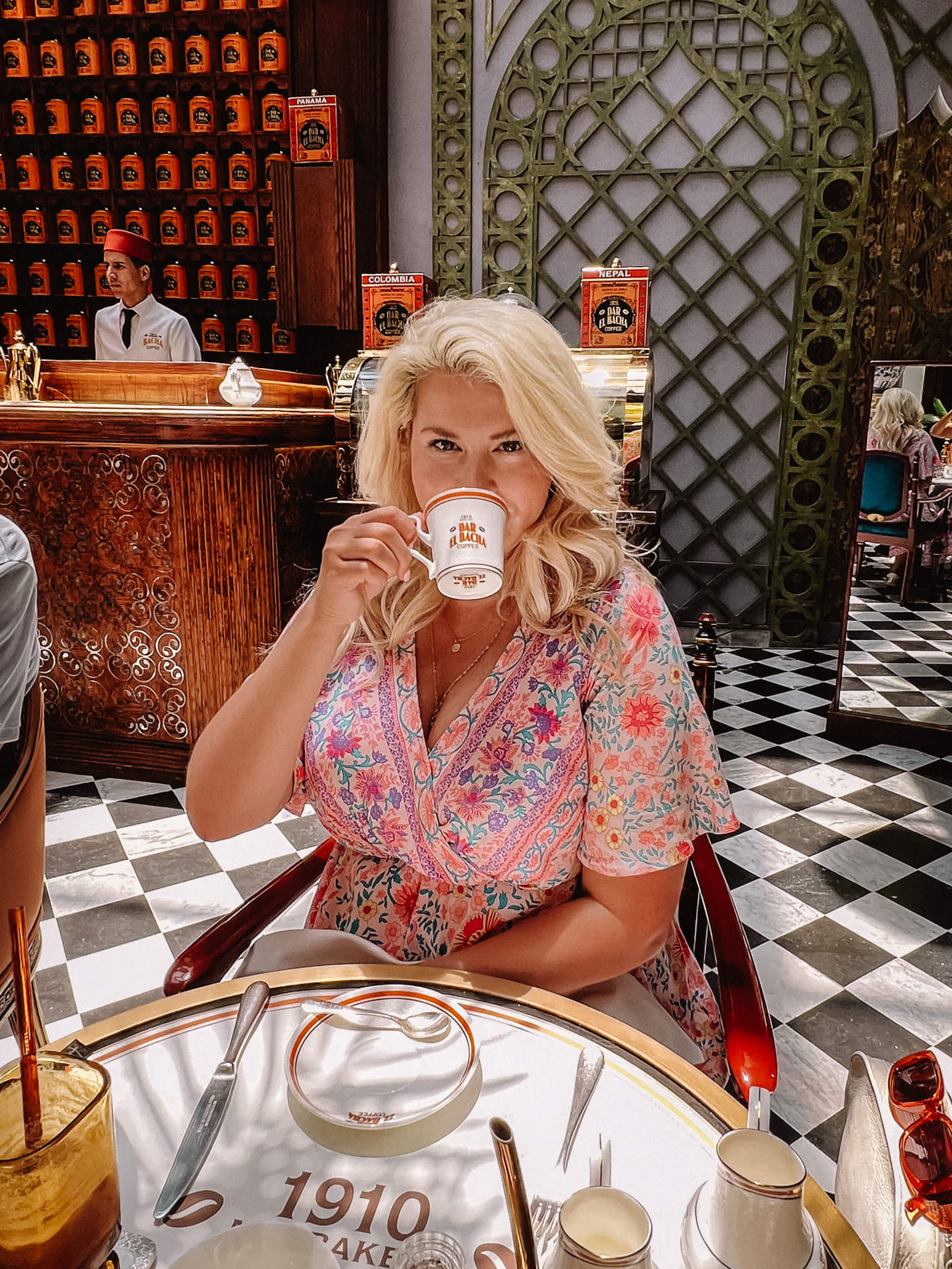
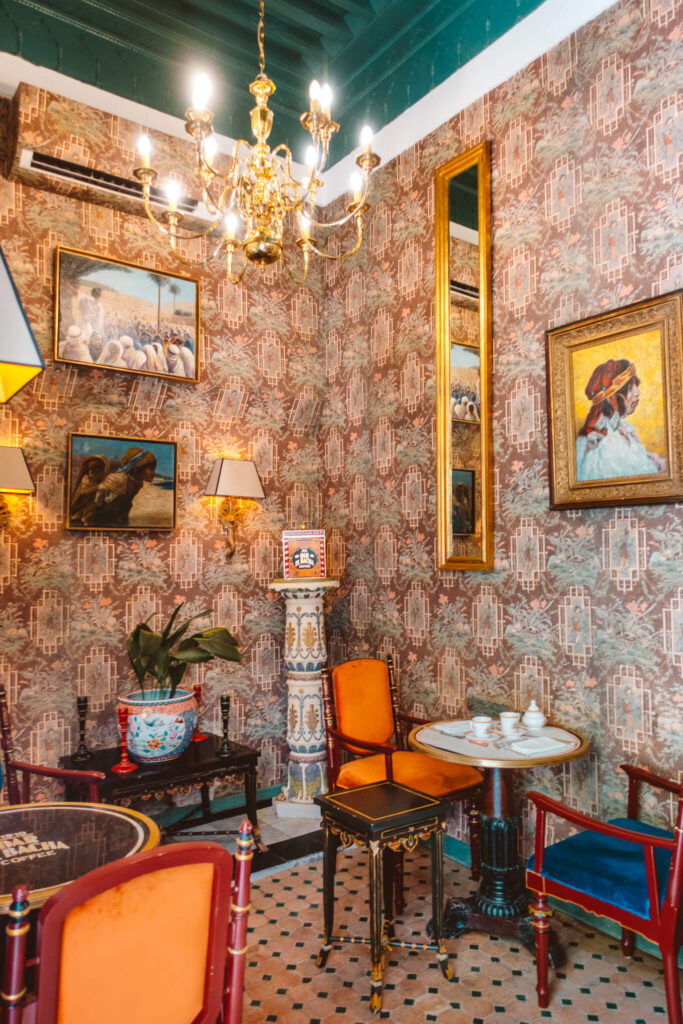
They serve over 200 single-origin 100% Arabica coffees from all over the world. It’s a bit overwhelming but our server helped us make some selections from the enormous menu. We ordered both hot and iced coffees and everything was incredible. And, if you order an iced coffee, you get to keep the beautiful glass straw as a souvenir!
Itinerary Note: Le Jardin Secret is right next door to Dar El Bacha (entrance fee is 80 dirhams / about 8 USD) so if you would like to visit, this would be a great time to do so! We had planned to visit but after exploring the Marjorelle gardens all morning, we decide to skip these gardens… I’d love to see them on my next visit to Marrakech though!
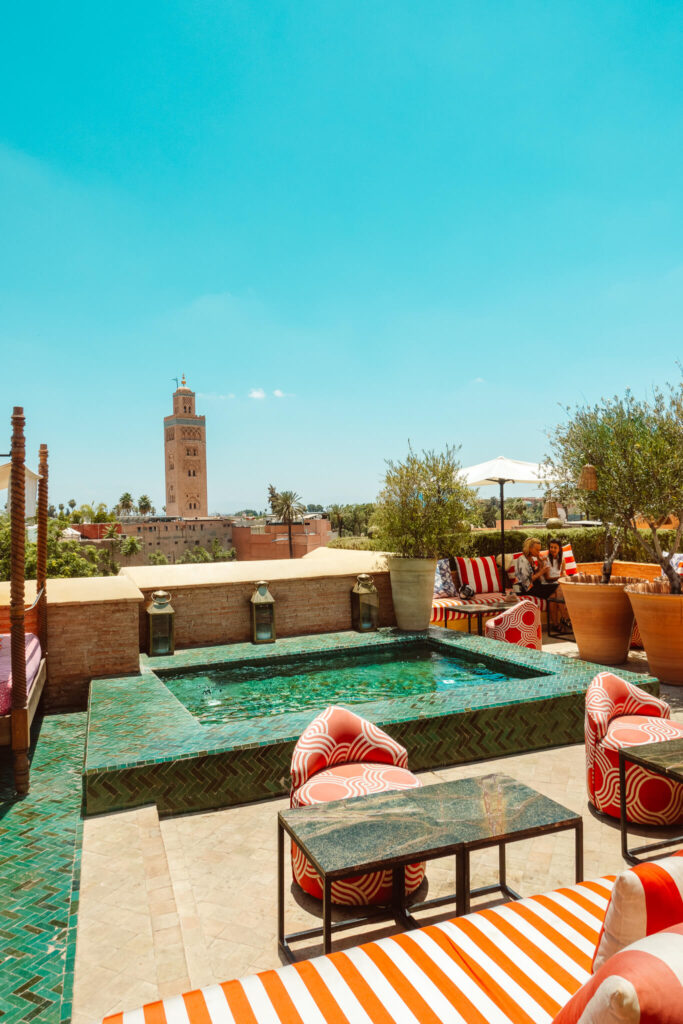
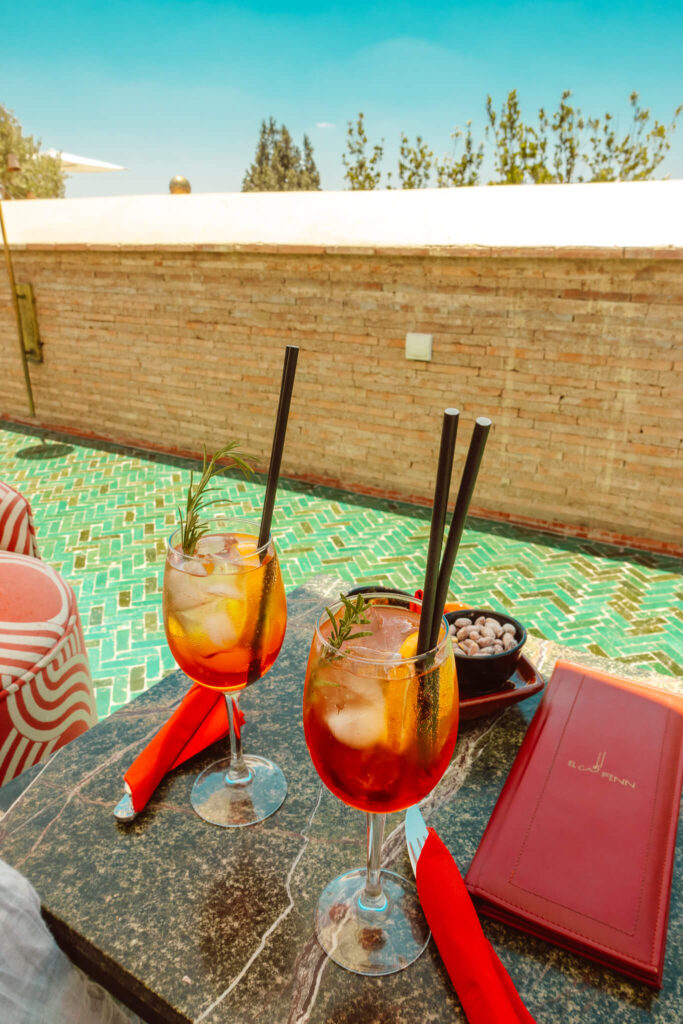
Lunch at El Fenn
After our morning exploring botanical gardens, palaces and museums, we were ready to eat so we stopped for lunch at El Fenn.
El Fenn is a luxury boutique hotel located in the heart of the Medina. It’s a stylish and intimate riad, offering a blend of traditional Moroccan architecture, contemporary design, and upscale amenities.
The property was originally a private residence before being transformed into a boutique hotel by Vanessa Branson (sister of Richard Branson) and Howell James in collaboration with local artisans and designers.
We visited the rooftop terrace for lunch, and were delighted by the panoramic views of Marrakech’s skyline. The rooftop has a restaurant, bar and multiple pools (a swimming pool and a dipping pool) and the overall vibe is very chic!
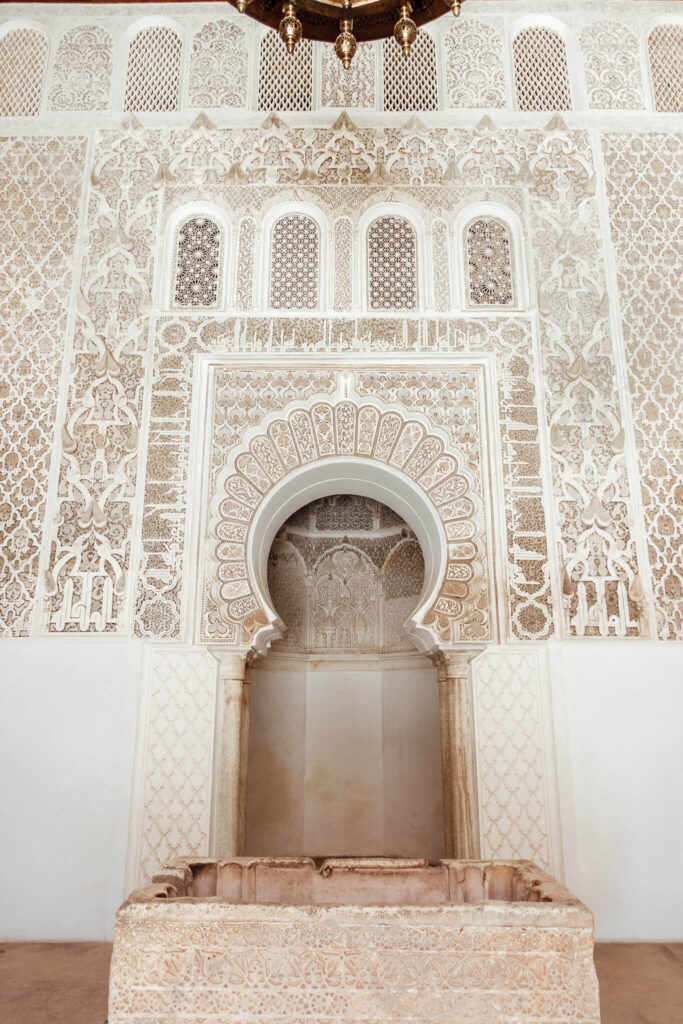
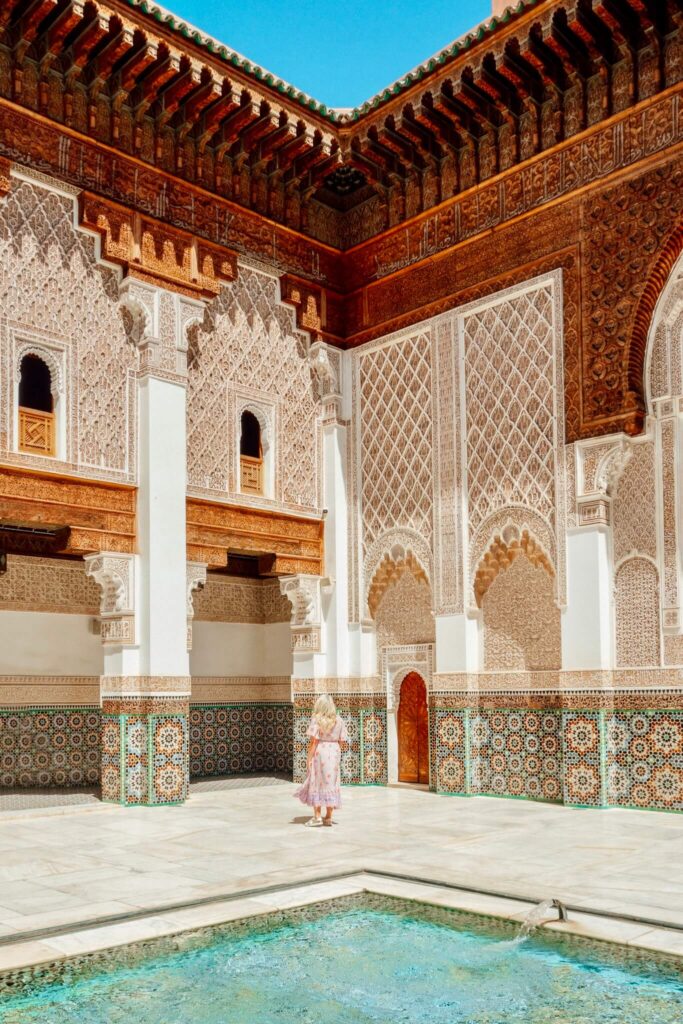
Ben Yousef Madrasa
The Ben Youssef Madrasa (also spelled Medersa Ben Youssef) is an ancient Islamic college located in the heart of the Medina. It stands as one of the most important historical and cultural landmarks in the city, known for its stunning architecture, intricate design, and rich historical significance.
Today, visitors can explore the peaceful atmosphere, admire the ornate decorations, and learn about the historical and cultural significance of the site. Tickets can be purchased at the entrance for 50 MAD (about $5 USD).
Dinner at Le Salama
Located in the Medina by the famous Jemaa El Fna square, Le Salama is a restaurant with three floors including an outdoor rooftop terrace with sweeping views of the city. Featuring playful decor, the atmosphere is buzzy and hip — with evening music and entertainment like belly dancing.
The menu features Moroccan classics like tagines, couscous, meat skewers, and an assortment of Moroccan salads. A great final evening for this 3 days in Marrakech itinerary!
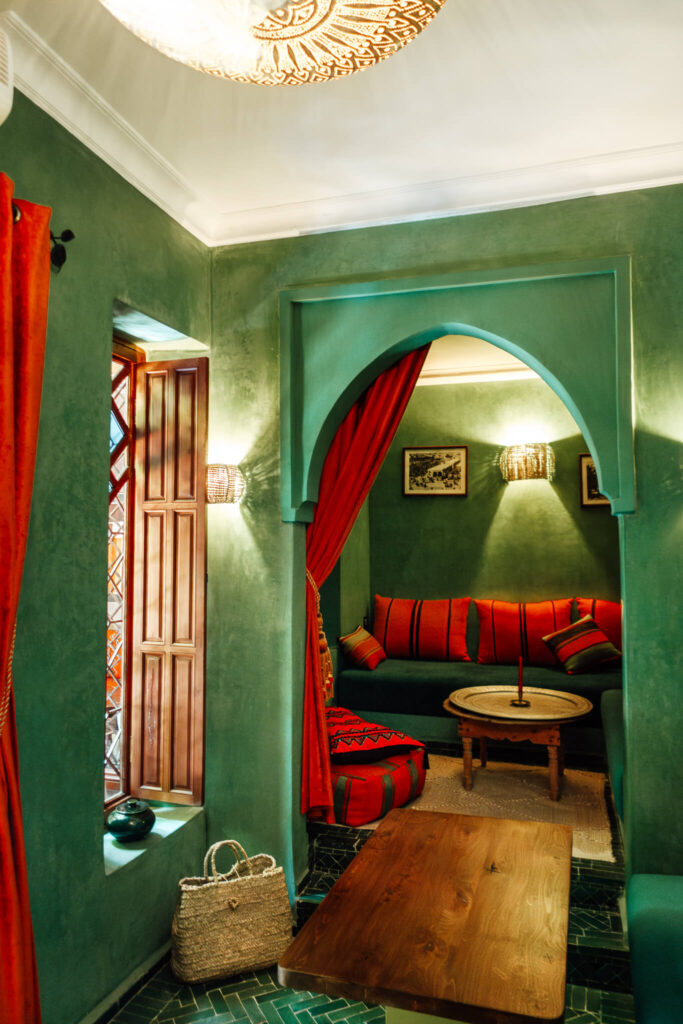
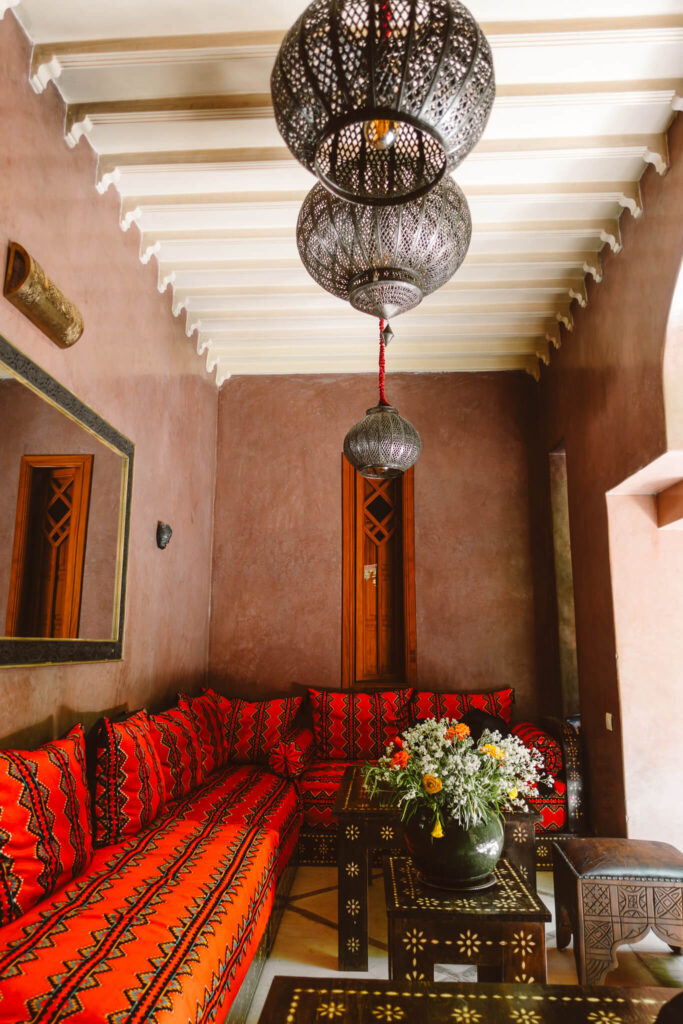
Where to Stay in Marrakech
The city offers a wide range of accommodations, from luxury hotels and resorts to budget-friendly hostels and traditional riads, catering to various preferences.
What is a riad?
A riad is a traditional Moroccan house with an inward-facing courtyard. Today, many of these riads have been converted into guesthouses or boutique hotels for tourists. It’s an excellent way to get a feel for traditional Moroccan life while visiting Marrakech!
While planning my trip to Marrakech, I decided to stay in a riad to get the full Moroccan experience (which I loved!), but I did a lot of research on both the hotels and riads in the city so here are my top picks:
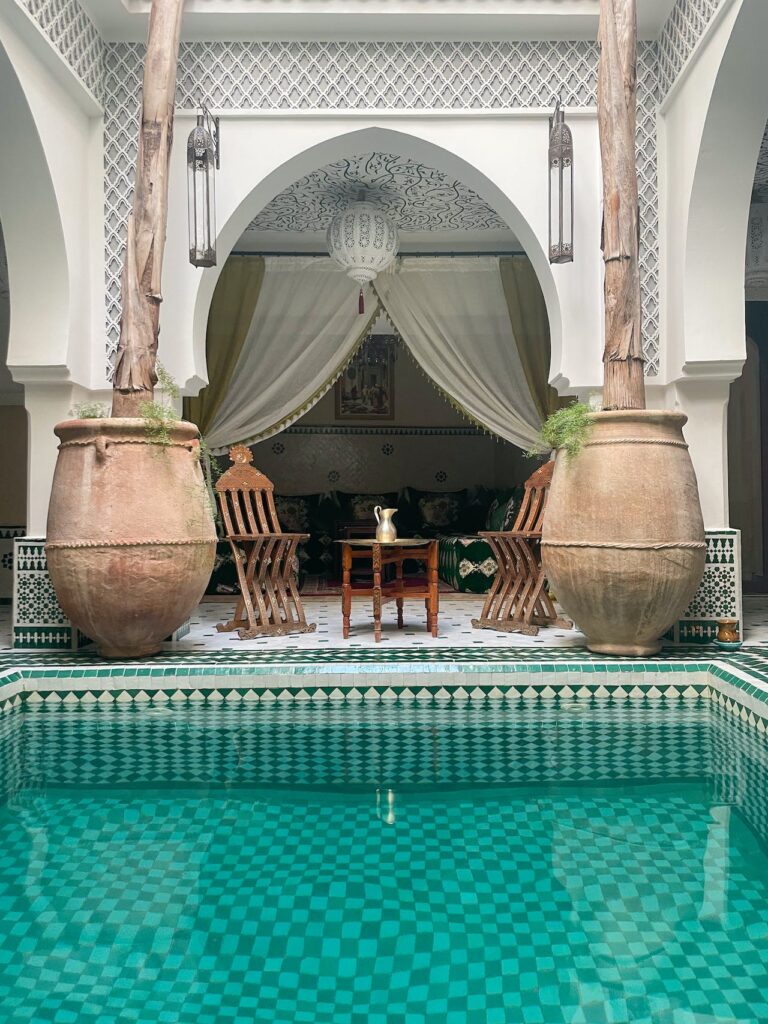
Luxury
Four Seasons Resort Marrakech: This luxurious hotel offers opulent accommodations, beautiful gardens, and top-notch amenities, providing guests with a lavish experience in this vibrant city. Guests can expect all the comforts of a Four Seasons hotel with a Moroccan twist!
Royal Mansour Marrakech: Looking to be totally pampered in an over-the-top luxury hotel? The prestigious Royal Mansour is renowned for its exquisite architecture and personalized service. Each suite in this opulent property is individually designed and features lavish interiors, creating a truly luxurious and unique stay for guests!
Palais Ronsard Relais & Chateaux: A beautiful and luxe hotel with prices that are slightly more down-to-earth than some of the ultra luxurious hotels like the Royal Mansour or La Mamounia. It’s just outside of town and features ornate suites, an expansive swimming pool… and even peacocks on the property!
Amanjena: If I had to pick one hotel that I’m most keen to stay at, Amanjena would be it! Aman resorts are known for their incredible properties, friendly service and extreme attention to detail. And, the design of Amenjena looks out of this world beautiful!
Mandarin Oriental Marrakech: Located just outside of the city, Mandarin Oriental Marrakech has an enormous property with 54 private villas, expansive swimming pools, and even a golf course. Known for its elegant design, lush gardens, and exceptional service, the hotel offers a tranquil retreat with a blend of traditional Moroccan and contemporary influences.
La Sultana: While most of the luxury hotels are located outside of the Medina or a short drive away from the city, La Sultana has a prime position inside the Medina! This gorgeous riad style hotel has beautiful rooms, a rooftop terrace, an outdoor swimming pool, and even a hammam style spa.
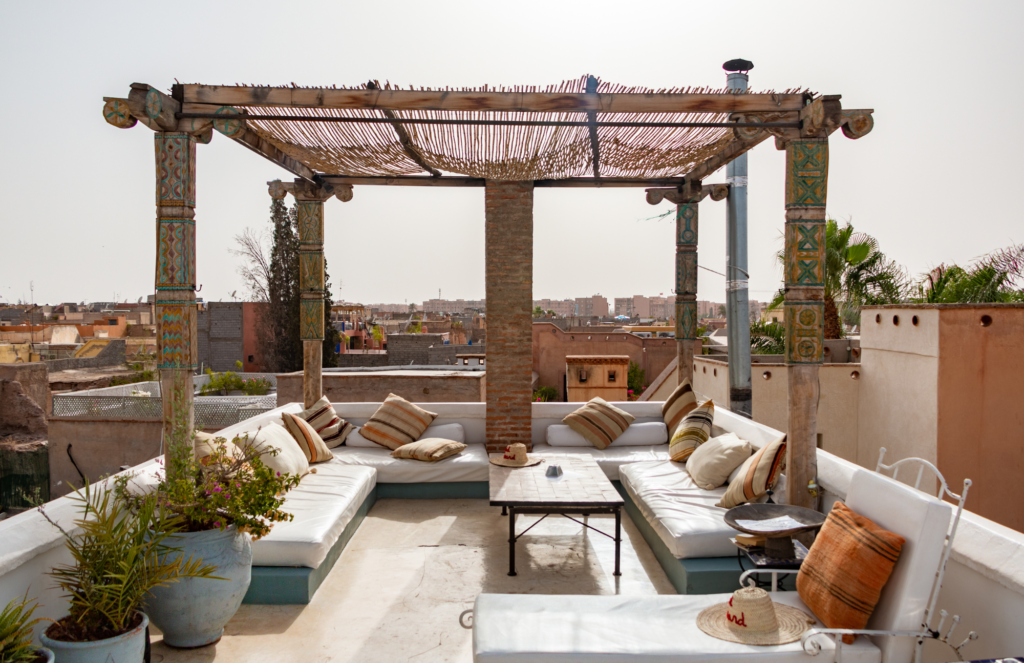
Mid-Range
Riad BE: This charming riad has such a gorgeous and photogenic design that it books up months in advance. If you can nab a room, it’s worth the stay!
Riad Botanica: A riad that feels like a total oasis in the Medina, Riad Botanica has six deluxe guest rooms with ensuites. With a tranquil ambience and exquisite design, you’re in for an ultra stylish stay.
Les Jardins De La Médina: Set within a historic riad and surrounded by beautiful gardens. Known for its serene atmosphere, traditional Moroccan architecture, and attentive service, it provides a relaxing escape in the heart of the city.
Les Deux Tours: A boutique hotel offering a peaceful oasis with lush gardens and stylish accommodations. Guests particularly love the pool area, restaurants and friendly staff!
Riad Kniza: A riad located in the heart of the historic Medina and known for its traditional Moroccan architecture, personalized service, and authentic decor, it provides a serene and culturally rich experience for guests. Guests can enjoy the outdoor pool, as well as sauna and steam room!
Dar Darma: Located in the Medina near the Grand Souk, this riad has a chic and moody Moroccan atmosphere. The suites and beautifully designed and well-appointed, and there is a rooftop terrace where guests can enjoy breakfast.
Almaha Marrakech Restaurant & Spa: Another gorgeous riad option in the Medina, close to the Saadian Tombs. Guests love the outdoor swimming pool, rooftop terrace and relaxing hammam!
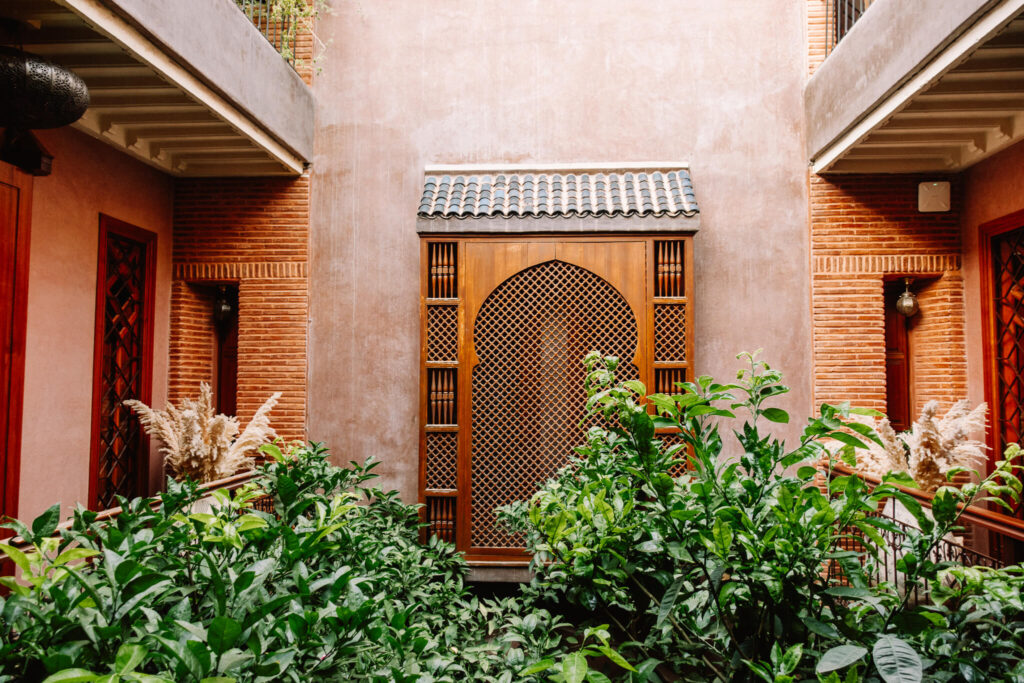
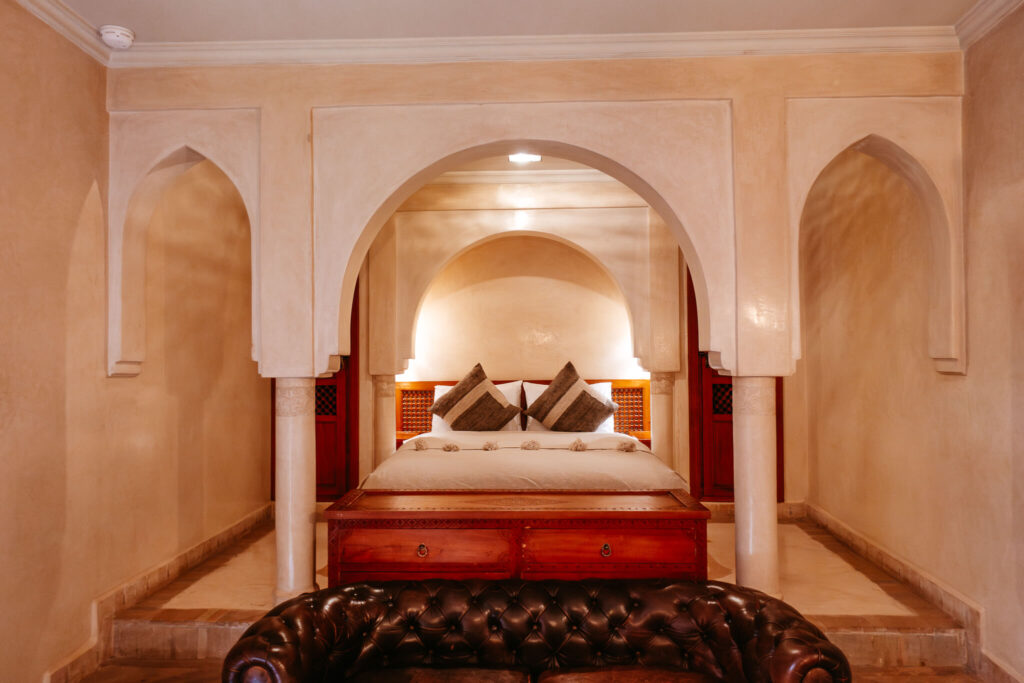
Budget
Riad Livia: For my 3 days in Marrakech, I stayed at this picturesque riad in a quieter part of the Medina. The rooms were comfortable and stylish, the lobby was filled orange blossom trees, and the rooftop had stunning views with a little dipping pool. Each morning, the staff brought us a delicious breakfast spread on the rooftop — we loved the service and all of the food!
Riad Nelia: This beautiful riad features a stunning interior with traditional Moroccan design making it very photogenic! Riad Nelia is very popular and sells out months in advance so make sure to plan ahead with your booking.
Riad Palais Calipau: A stunning riad, located in the heart of the Medina, that offers a traditional experience of Morocco in a lively part of Marrakesh. Guests love the convenient location, gorgeous architecture, outdoor pool, hammam spa, and rooftop terrace — what more could you need for the perfect riad experience?!
Riad L’Atelier: This ultra stylish riad feels like a hidden gem in the center of Marrakech. One of the most beautiful features is the outdoor swimming pool surrounded by intricate Moroccan tiles.
Riad Dar Talah: A beautiful riad with lovely rooms, a charming terrace and freshly made breakfast each morning. The perfect tranquil stay for your visit to Marrakech!
Traveling with a group? You can rent your own private riad to enjoy with family and friends! Riad Alkemia is a beautifully designed riad with 6 bedrooms, a swimming pool, outdoor terrace, hammam spa, and 24 hour concierge!
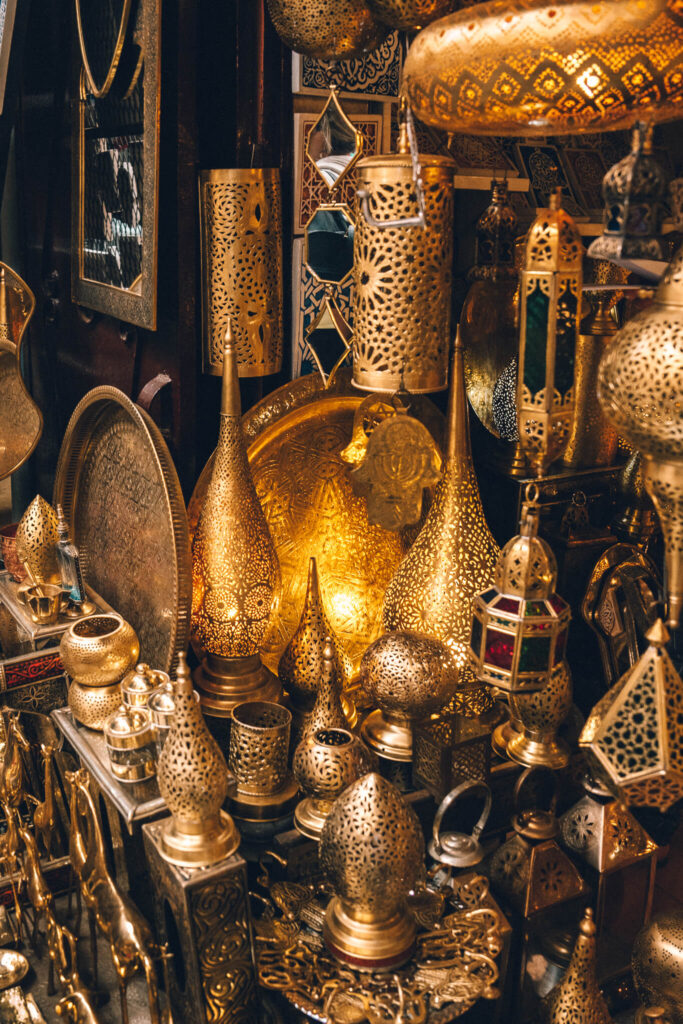
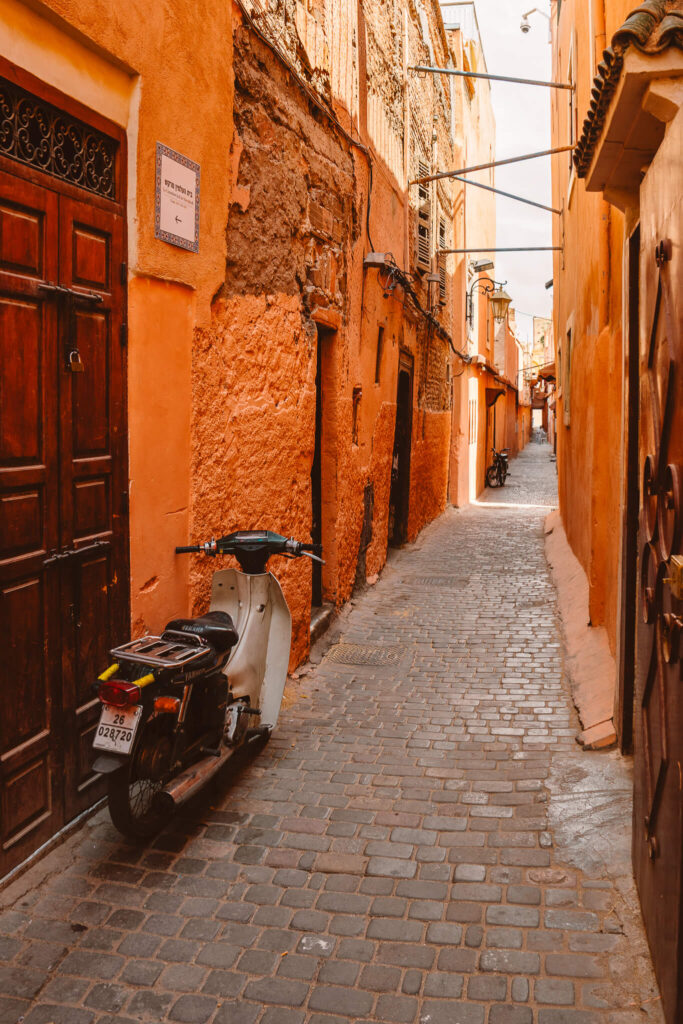
Tips for Visiting Marrakech
Keeping these tips in mind will help you navigate your 3 days in Marrakech more comfortably and respectfully, enhancing your overall experience in this vibrant and culturally rich city.
Bargaining and Shopping: Bargaining is common in the souks (markets) but don’t feel pressured to buy if not interested. While the shopkeepers can be pushy, the best thing to do is walk away if you don’t want to make a purchase.
Quality Check: Inspect items thoroughly before purchasing, especially in markets, to ensure quality. If you plan to make a big purchase (like furniture or rug), I would do some research beforehand on what to look out for or perhaps ask the assistance of a knowledgeable guide. Our guide showed us some things to check for when it comes to purchasing rugs, plus he knew the most reputable shops to visit.
Sun Protection & Hydration: Use sunscreen, wear hats, and sunglasses to protect yourself from the sun because it sure is strong! This probably seems like an obvious tip but honestly it can sneak up on you. We were having lunch on a rooftop without shade on the hottest day of our visit and I started to feel lightheaded and dazed… We moved to a shady spot and I drank lots of water but it took a little time before I felt back to normal!
Awareness of Surroundings: Be extremely cautious of pickpockets in crowded areas. Keep valuables secure and be very vigilant, especially in Jemaa el-Fnaa square where you can be easily distracted by the bustling surroundings.
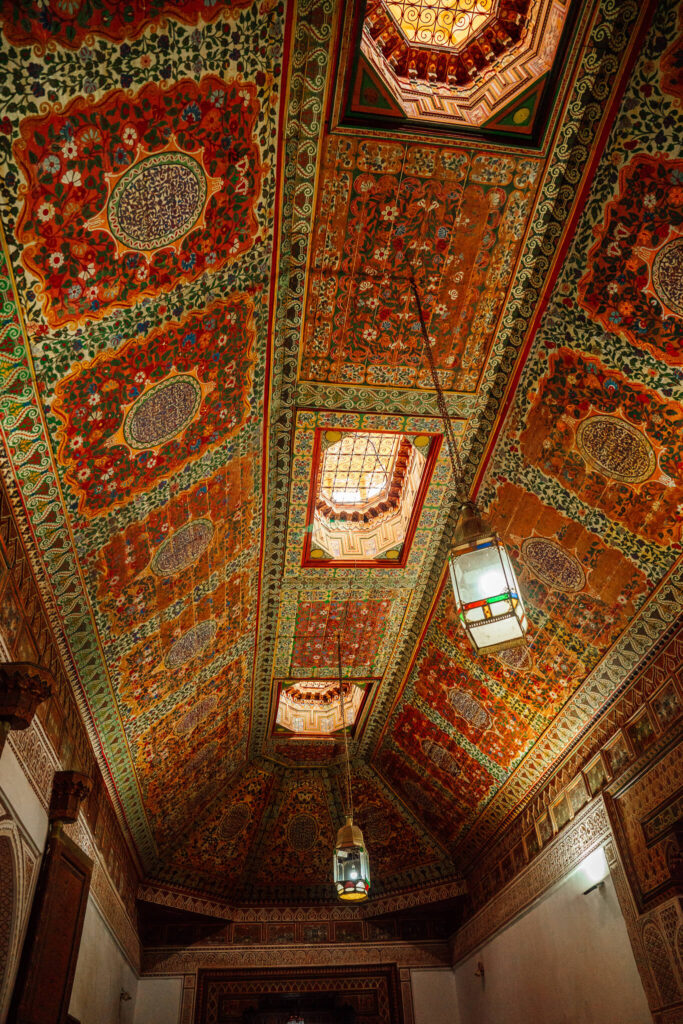
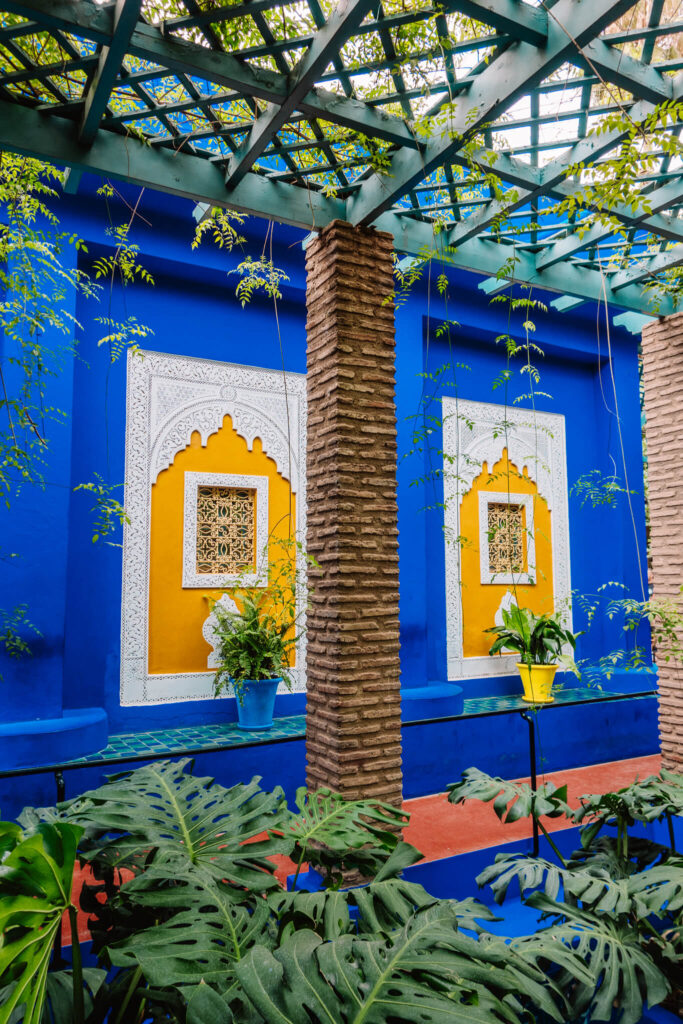
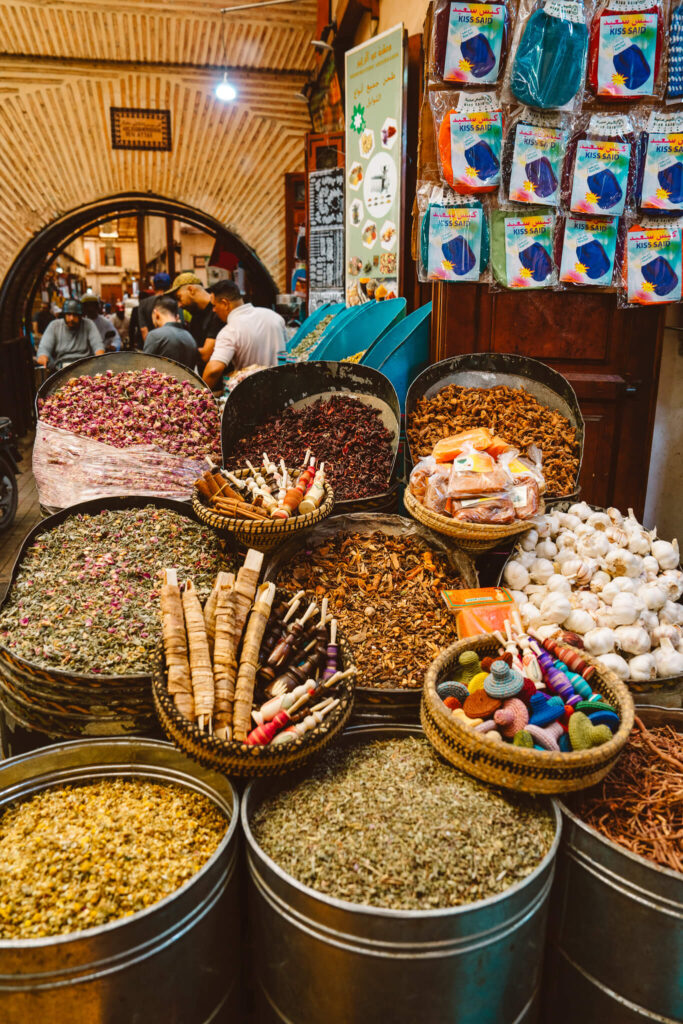
Say No to Unwanted Services: “La, shukraan” means “no, thank you” in Arabic and can be helpful when locals are offering you a service that they will then expect money for. Beware of ladies who want to take your hand for a henna tattoo as they’ll demand money in exchange. Similarly, say no to locals offering directions to your destination or the entrance to a museum. Some tourists have been swindled and taken to an unofficial entrance where they pay a higher entrance fee.
Food Hygiene: Enjoy the local cuisine but be cautious with street food. Eat from reputable vendors to avoid stomach issues. This usually means eating at the busiest vendors — they are popular for a reason!
Ask Permission for Photos: Respect locals’ privacy and customs regarding photography. Always ask for permission before taking photos of people or their belongings. I was very nervous about taking photos in the Medina as I had heard some travelers were scolded for doing so. But our guide encouraged me to do so and asked shopkeepers whose stalls I wanted to take photos in. I made sure to avoid taking any photos of people’s faces wherever possible!
Tipping: While tipping isn’t mandatory, it is customary to tip 10-15% at restaurants and with tour guides, especially in touristy areas. You can also leave 10-20 dirhams for service workers and taxi drivers. And, if you’re staying in a riad, it’s also nice to leave a tip for your riad host if they have been helpful during your stay.
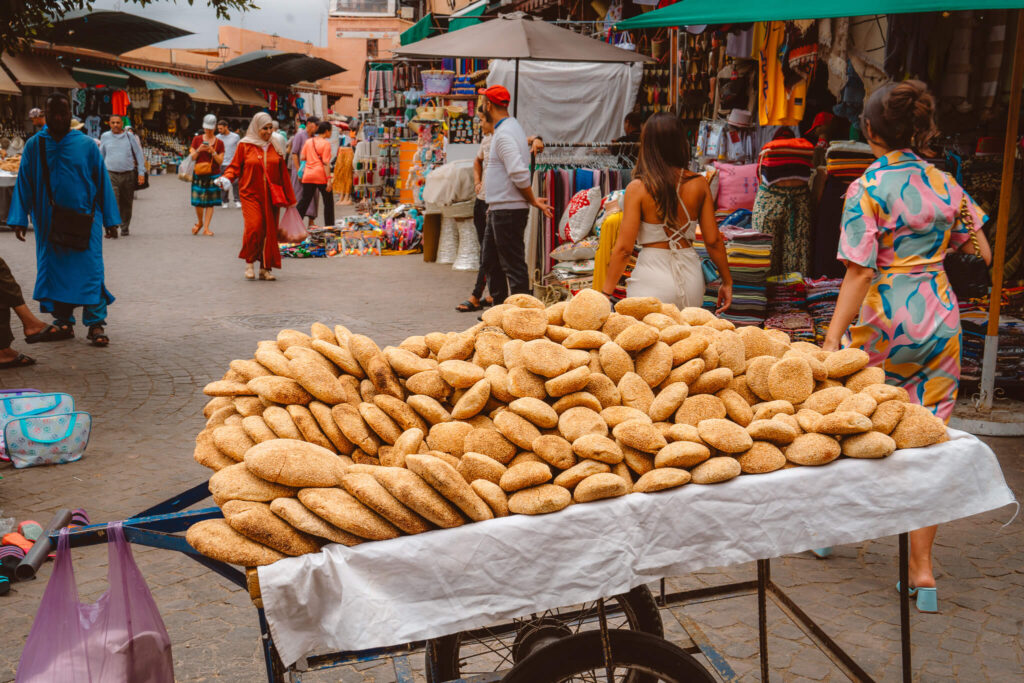
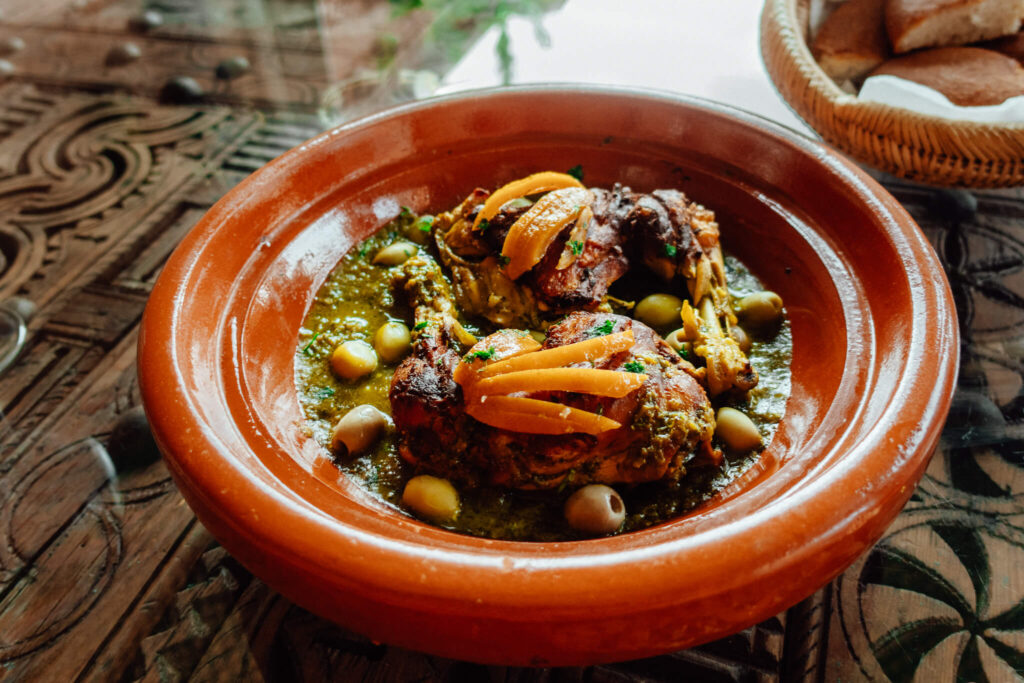
What to Eat in Marrakech
Marrakech offers a rich and flavorful culinary scene with a diverse range of dishes that showcase the vibrant flavors of Moroccan cuisine. Here are some must-try foods during your 3 days in Marrakech:
Chicken, Lamb, or Vegetable Tagine: Tagine refers to both the dish itself and the conical clay pot it’s cooked in. It’s a slow-cooked stew with meat, vegetables, spices, and sometimes dried fruits, resulting in tender, flavorful dishes.
Couscous with Meat or Vegetables: A staple in Moroccan cuisine, couscous is made from semolina grains and served with a variety of toppings like lamb, chicken, or vegetables in a flavorful broth.
Pastilla (B’stilla): Pastilla is a traditional Moroccan pie made with layers of thin pastry filled with shredded meat (often pigeon or chicken), almonds, spices, and topped with powdered sugar and cinnamon. It’s a unique blend of sweet and savory flavors.
Harira: This hearty soup typically contains tomatoes, lentils, chickpeas, lamb or beef, and a blend of aromatic spices like cumin and coriander. It’s commonly enjoyed during Ramadan to break the fast.
Mechoui: Mechoui is a traditional whole lamb dish, slow-roasted for hours until the meat is tender and flavorful. It’s often prepared for special occasions or celebrations.
Moroccan Salads: Explore a variety of Moroccan salads, including Zaalouk (eggplant and tomato salad), Taktouka (roasted pepper and tomato salad), and others, often served as starters.
Moroccan Mint Tea: Moroccan mint tea is a staple drink made with green tea, fresh mint leaves, and sugar. It’s served hot and is an essential part of Moroccan hospitality.
Moroccan Sweets: Indulge in Moroccan desserts like Baklava, M’hanncha (snake cake), or Sellou (a sweet nutty confection) often enjoyed with Moroccan mint tea.
Exploring the diverse flavors of Moroccan cuisine is an essential part of the Marrakech experience. Don’t hesitate to explore local restaurants, street stalls, and markets to savor these delicious dishes during your visit!
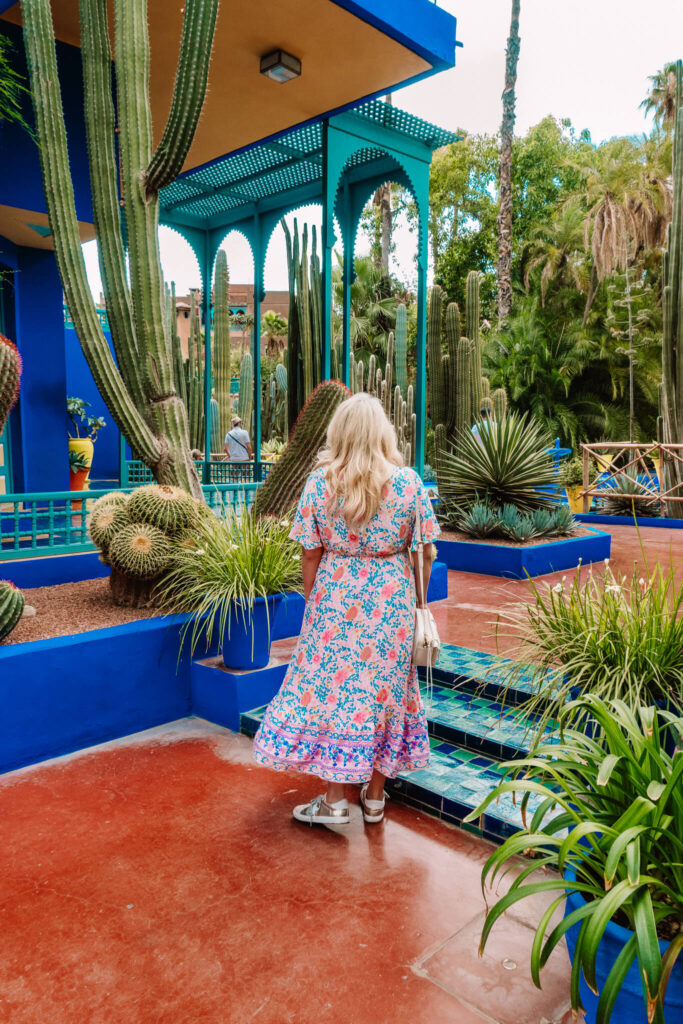
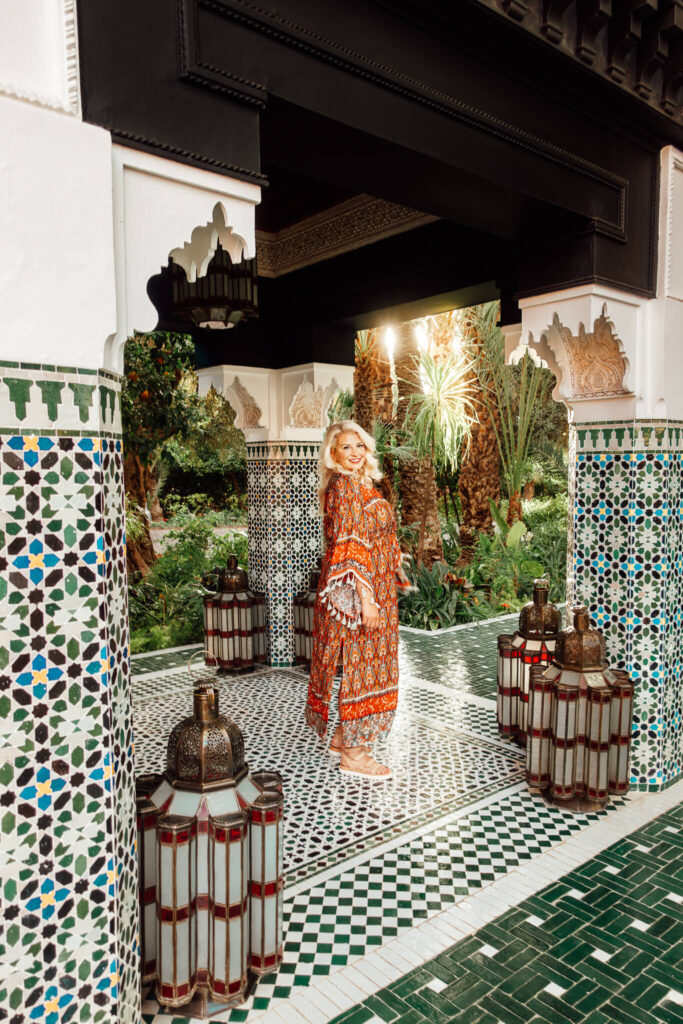
Marrakech Outfit Inspiration
That’s a wrap on the 3 days in Marrakech itinerary! Now it’s time to plan your visit to the Red City and experience the enchanting souks, picturesque riads, and magical desert sunsets.
Great guide for a trip to Marrakech. Do you have contact information for your guide? Thanks!
So sorry, I don’t have his contact — it was a guide that we set up through our riad the night before so it wasn’t really set up in advance. Hope you enjoy your time in Marrakech! 🙂